Cannibal Halfling Gaming


Star Trek Adventures In-Depth Review
Gamemaster’s Log, Stardate 57252.7. It has been several months since the launch of the New Orleans -class starship U.S.S. Verrazzano , NCC-07302, from the Foggy Peak system. Since that time, I have seen her crew serve with distinction in accordance with the finest traditions of Starfleet. I have also seen them called before a board of Admirals to review their actions and directive violations, and while impressive the fact that no fewer than three starbases have had to be commissioned to deal with the discoveries from their missions is beginning to put a notable dent in the power requirements for the local sector’s industrial replicators. As the Verrazzano is currently away, responding to a distress call from a Vulcan Expeditionary Group, I have decided that this is a fine opportunity to review their so-called ‘ Star Trek Adventures ’ in-depth, to better understand how they have and will continue to boldly go where no one, not even the rest of Starfleet, has gone before.
Characters and Core Mechanics
The most basic mechanic for Star Trek Adventures is this: you’re rolling 2d20, and you’re trying to get results on the individual die that are equal to or lower than a target number. The more results that are equal or lower, the more successes you get, and different actions will require a different number of successes. A task requiring 1 or 2 successes is quite possible, but obviously if you need any more than that you’ll need something special. Enter the crew of your Starfleet vessel. Characters have six Disciplines that represent their specialties in Starfleet (Command, Engineering, Science, etc.) and six Attributes (Fitness, Daring, Insight, etc.) which represent their personal abilities. When you’re facing a task, your target number is determined by a combination of a Discipline and an Attribute: Security+Control to fire a phaser, Conn+Daring to fly a runabout through exploding asteroids, Medicine+Reason to diagnose an alien virus.
Characters are built through a series of stages that gradually build these stats up: species, background (plus whether you accept or reject your upbringing), what branch of Starfleet you go into, and a series of career events like being forced to call out a superior, making scientific breakthroughs, or a conflict with a hostile culture. Along the way they’ll pick up Talents that enhance or grant extra abilities, and Focuses that can (if they can roll underneath their Discipline rank as well as the target number) grant a second success on a check. Characters also define Values, things that they care about and believe. All of the other stuff is about what your character can do; Values are about who your character is . All of this leads to characters that just . . . they just click very easily. Values provide a challenge, as while there is advice on how to create some, they are entirely unique to every character, not picked from a list. But overall creation is simple, and you immediately have a lot to work with mechanically and narratively.
Aboard the Verrazzano , that gets us the Vulcan Captain Salok, forced to take command, who focuses on Diplomacy with a firm belief that Diversity Is Strength. His first officer, the Gnalish Commander Korg, strives to Defend and Aid Those In Danger or Need and is a known friend to the Klingons. Lt. Commander Flint Northrock’s file is mostly redacted, but he is a particularly Bold helmsman: “ My answer to any distress call is “’I’m Coming’”. Lt. Commander Be’zur is the ship’s Chief Engineer, a Liberated Caitian Borg with a knack for Improvised Technology, a talent for pushing things Past the Redline, and a conviction that There’s No Such Thing as The Unknown, Only the Temporarily Hidden. Lieutenant, later Lt. Commander, Ava is a sliver of an extra-dimensional being; naturally, he serves as the Science Officer with A Mind for Design and Insatiable Curiosity about the universe he finds himself in. The Bajoran Lieutenant (j.g.) Edon Reil might be a relatively young officer but he has Untapped Potential, and serves as a fine Chief of Security: “Beware invaders calling themselves ‘friend’”.
Here’s something to consider, especially if you’ve been playing games that are more hardscrabble: STA characters can be extremely competent in their particular area of expertise. It’s certainly possible to build something akin to a generalist, but given that characters are naturally going to gravitate towards certain roles (the Captain, the Chief Engineer, the Science Officer) it’s very easy for them to have a target of 17 or so for their primary focus (5 in Science and 12 in Reason for the Science Officer, for example). Speaking of Focuses, if chosen well there are plenty of opportunities for them to come into play, offering multiple successes on a die. As I’ll address shortly, there are multiple ways to roll 3 or even 4d20 just on your own, as well as a way to automatically get at least two successes. Other characters can assist you, and if you’re on your starship it usually contributes another d20 to the pile as well.
Some actions are going to be impossible, and you’ll need to create an advantage to make them something you can actually achieve. I’ve read the number of successes called out as being impossible as five, though, and that’s . . . not really the case. Seeing six, seven, and even eight successes hit the table isn’t common, but it’s not all that rare either. So, a minor but important point, while needing 4 successes is probably still a good high-water mark, I would keep the reason for a task being impossible as purely narrative.
So, in short, this is not a game with an awful lot of failure, further reinforced by the fact that you can Succeed At A Cost, with ‘failing forward’ actually being built into the mechanics outright. STA is more about characters figuring out what needs to be done and how they want to do it than whether or not they’re going to succeed, followed by the consequences of their actions (even if they succeed) as further enabled by the aforementioned costs and Complications. On the one hand, GMs shouldn’t be too concerned if things seem ‘too easy’ for their players at first blush. On the other, well, a few things: don’t be afraid to ask for three or four successes on really difficult and important stuff, you can get a little extra challenge by throwing things slightly out of a character’s area of expertise at them, and when failures do come up they need to matter. When Northrock (who includes among his Values ‘The Best Way to Defeat An Enemy Is To Make A Friend”’) failed to resist the impassioned plea of an oppressed species convincing him that patience and diplomacy would not work, that he would have to violate the Prime Directive, that needed to have an impact. It actually kicked off a small not-mutiny, actually, along with a few other consequences that I’ll get to use as examples later.
Meta Latinum
There are three types of metacurrencies in Star Trek Adventures: Momentum, Threat, and Determination.
Momentum is a player resource, gained via extra successes – 3 successes on a Difficulty 2 check, you get 1 Momentum. Momentum has a lot of uses. When used immediately it can be used to boost attacks by doing more damage, ignoring Resistance, or activating weapon traits. It can be used to create Advantages that can make future tasks easier or impossible tasks possible. In my experience it is most commonly used immediately to Gain More Information , a key use that often sees characters diving past their basic observations to really discover what’s going on or what they’re dealing with. If not spent immediately, however, points of Momentum go into a pool; they can be used in several ways once there, but by far their most common use is buying more dice to roll for a check. A 3rd d20 costs one Momentum, a 4th one costs two.
Threat is primarily a GM resource, and in several ways it mirrors Momentum. It can be used for adversaries rolling extra dice, it can make attacks lethal (by default they are not), it can make tasks more difficult or increase the chance of a Complication (something Bad that usually only happens if a character rolls a 20 on a die). With enough Threat in their pool GMs can even end scenes entirely and take narrative control, which strongly reminds me of the Doom Pool from Cortex games.
GMs begin every mission with twice as many points of threat as there are players, which is good, because in my experience you’re not likely going to get too many more. There are a couple ways to add more Threat, but the only one that doesn’t require a specific circumstance is that player characters can also use Threat by choosing to give it to the GM instead of spending Momentum at the same rates. That’s great, because it gives the GM more to play with and gives the players options if they run out of Momentum. Honestly, though, it doesn’t seem to happen very often. A large part of this is certainly biased in this specific campaign by the luck of the dice and the characters themselves. The Verrazzano crew have often been able to generate more than enough Momentum for their needs, rarely running completely out. Also, the entire line of Bold Talents, which let you re-roll dice if you have used Threat to enhance the roll, are designed to be a big motivator for Threat use – but only Northrock and Reil have any of them, and they both have only the Conn variety. So, you might find yourself with players giving you oodles of Threat . . . just be prepared to use what you get at the start of a mission carefully, if you don’t.
The final metacurrency is Determination, and it’s the big one. Every character starts a mission with at least one, and it is deeply tied to the character’s Values: if they are acting in accordance with a Value, a character can spend a point of Determination to add a die to their roll that is automatically set to a result of 1, meaning an automatic two successes towards the roll. Note that this still counts as adding a die a la Momentum/Threat, in that if you want a 4th die you’ll need two points of those other resources, but still! Alternate uses of Determination still require you to be acting in accordance with a Value, but include: re-rolling all your dice, immediately taking another action on the same turn, and automatically creating an advantage.
You can get more points of Determination if you challenge a Value, meaning your character is having a big think about whether or not they actually believe that any more. You can also be offered Determination by the GM to compel you to act in line with a Value when it would make things more difficult for you, which reads an awful lot like Fate points. Determination isn’t just a big deal because of the mechanical impact, although that can’t be undervalued either. But since Determination, whether spending it or gaining it, plugs into your Values it is often a very important factor in your characters ‘leveling up’.
Advancement
‘Milestones’ are the method of advancement in STA, and there are only three ways to get them: suffering (and surviving, obviously) a lethal injury, challenging a Value (thus getting a point of Determination), and using a Value either positively or negatively (meaning you either spent or received a point of Determination while acting upon it). You get a ‘Normal’ Milestone for just doing one of the above during a mission. The GM can award a ‘Spotlight’ milestone if a character or characters would earn a Normal Milestone and also made a particularly big impact in a mission, and the players decide who among them receive it. Eventually, you acquire enough Spotlight Milestones that your next one is an ‘Arc’ Milestone instead (or, if the GM feels it appropriate given the character’s actual narrative arc, they can award one out of hand). Here’s the thing, though: the Arc Milestone is the only one that actually adds anything to a character.
With a Normal Milestone, first of all, if a Value was challenged it gets rewritten or replaced to reflect how the character’s perspective was changed. After being forced to realize that “The Best Way to Defeat An Enemy Is To Make A Friend” would not always be the case, and subsequently getting in a fair bit of trouble for acting as such, Northrock reaffirmed his commitment to the crew and to following Salok’s lead instead of going off on his own: “When The Way Is Unclear, I Follow My Captain.” Aside from that very cool and dramatic and character-growth-driven aspect, though, Normal Milestones are very light: you can move a point from one Discipline to another, or replace one Focus with another. Spotlight Milestones let you pick one of the options from the short list of the Normal Milestone’s, as well as one of several others: moving points between Attributes, replacing a Talent, moving points between the ship’s Departments or Systems (Discipline and Attribute counterparts, really), or replacing the ship’s Talents. Arc Milestones grant the benefits of a Normal and a Spotlight Milestone, but are the advancement that finally lets you increase a Discipline or Attribute, gain an additional Talent, Focus, or Value, increase one of the ship’s Departments/Systems, or add another Talent to the ship.
As mentioned above, STA player characters are probably starting off as very competent just based on stats, never mind what their Talents can bring to the table, so they don’t really need to be growing mechanically all that much. What’s really important to this system is how their Values, what they care about and who they really are, are highlighted, are challenged, are grown and changed. Changing up Attributes, Disciplines, Talents, and Focuses also reflects this choice of priority – a Captain who starts to take more of an interest in what’s going on down in the warp core while leaving the navigation of the ship up to their hot-shot helmsman might shift a point from Conn to Engineering.
So far, they seem to be working just fine. Captain Salok and Lt. Commanders Northrock and Ava are both on the cusp of their first Arc Milestone as of this writing, and given how competent the characters are nobody seems to be minding that they haven’t been ‘gaining’ anything, and there have been comments that they like the idea of switching things around to better match the character – it’s true that you’ll certainly never have a dead-end Talent or Focus for very long.
I’ll admit that awarding the Spotlights has felt . . . a little anemic on the GM’s side of things. The book recommends giving out a single one every two or three sessions, but these are players and characters who have really taken the ‘Go Boldly’ thing to heart. Salok ‘crushed’ a mutiny with little more than an iron will and by convincing the mutineers that a starship takes many to succeed but only one to fail. Northrock took command of an absolute disaster involving a wormhole, a shapeshifter, friendly fire, and a dying ship and somehow got everyone out alive. Ava solved an astrogation and physics problem that had confounded Starfleet for decades , and then went on to help establish a stable wormhole to another universe . Be’zur’s technological monstrosities have caused me to throw out more notes and plans than any two other characters combined. Korg and Reil have both been responsible for saving the lives of their crewmates from certain death or worse, whether it was a rampaging tentacular plant unleashed from the Verrazzano’s labs, Orion raiders trying to steal an artifact powered by time , or a desperate and murderous Starfleet doctor gone rogue.
So, in short, I’m probably awarding Spotlights a little more frequently than the book would like me to, every other session at least, and I’m often throwing two out at once. Since Normal and Spotlight Milestone benefits can be banked for later, the system certainly doesn’t seem to be breaking as a result. If it were a longer, slower-burn campaign I might stick closer to the book’s recommendations but to be honest I think that, as with determining if a task is impossible, you’re best served by ignoring hard numbers and focusing on the narrative.
Support Characters
If there is any one mechanic that has been a runaway hit during the campaign, this has been the one. Supporting characters are the ‘extras’ on set, the people in the background of the show that only get speaking roles every few episodes, if ever. Star Trek Adventures lets you bring those characters into the spotlight by spending points of Crew Support – every ship gets an amount that is determined by how big the ship is, and then player characters can each take a talent to get more, which two Verrazzano crew members did. Broadly speaking there are two reasons to play a Supporting character. First, because they cover a skillset that the main player characters lack. This was the case of Lt. Gunther von Doomstone, the Chief Medical Officer, and Lt. Khumail Jaosh, the transport chief. The second is when it doesn’t make sense for a player character to be present, such as on away missions, but the player still wants to be a part of the scene. This was the case for Lt. Joran Mal, a Joined Trill diplomat, when Captain Salok had to remain behind on the ship. Sometimes it’s both. Cadet Groorin, part of the second wave of Ferengi following in Nog’s footsteps, appeared when the players decided Joran needed an assistant to deal with an upcoming legal tribunal, but really got played when Lt. Commander Northrock was stuck at the helm and there was a Ferengi away team to negotiate with.
I suppose there’s also a third reason, which is because you have a cool character idea you wanted to include. Lt. Jurling , Klingon Ship’s Counselor ( “It is a good day for conflict resolution!” ), was added to the crew to cover that role, yes, but mostly because I wanted him to be there. Consider it my payment for running the game.
Supporting characters start off comparatively light – their highest Attribute will be a 10, their best Discipline a 4, with three Focuses but no Talents or Values. Supporting characters don’t gain milestones themselves, although a player character can choose to use the benefit of one of their own milestones to switch things around for a supporting character. Instead, Supporting characters improve by the number of missions they appear in through the use of Crew Support – every time they show up they gain something, and while they still have lower caps (they can only ever improve a Discipline once, for example), they can still end up fleshed out quite a bit. Funnily enough, Supporting characters are thus going to ‘advance’ at a much faster rate than player characters will, which can help scratch the itch a little for those players who enjoy getting mechanical rewards.
Supporting characters are . . . kind of strange, in terms of gameplay and narrative. First of all, for groups with a lot of players they’ll end up taking up most of the NPC slots left on the ship – that hasn’t stopped me from making more NPCs, but it has felt a little odd to jump into a Supporting Character now and then as the GM.
They’re also supposed to be supporting characters but in many cases they’ve been in the spotlight just as much, if not more than, the ‘main’ characters, and some of them are quite beloved. Like any character, you end up wanting to make them interesting, and together we have. Doctor von Doomstone is from a planet that would have featured in a TOS Planet of Hats episode, a Frankenstein setting, and he’s trying to avoid going down the mad science path of his ancestors. Jurling has a reputation for unconventional ‘team building exercises’, a love of Klingon opera that’s shared with Commander Korg, and a genuine care for his patients. Joran quickly gained a reputation for being in over his head and soldiering on anyway, surrounded by literal piles of PADDS and joining the Captain in his coffee habit while reviewing First Contact protocols.
I wonder at what point you might just give up the charade and make them main characters in their own right with storylines of their own, capable of gaining milestones for themselves and surpassing the limitations of a supporting character. Perhaps a player could have multiple full characters (while many are shared, I’ve noticed some support characters functionally ‘belonging’ to a single player), or perhaps the ‘upgraded’ characters could remain in a pool for troupe play, which would keep the pool of Crew Support fully functional.
Supporting characters as a concept have also highlighted for me the need to have time spent back on the ship and in the ready room, for the simple reason that the Captain just doesn’t leave the ship very often. In terms of ‘screen time’, Aaron has spent more time portraying Lieutenants Joran and Jurling than he has Captain Salok, and yet the Captain has still managed to net himself some Spotlight Milestones, primarily on the bridge and in the aforementioned ready room.
Material to Work With
Star Trek Adventures is extremely well-supported. Since release there has been a unique book for all of the galaxy’s quadrants, another one each for Command, Operations, and Science, two full mission anthologies, character profiles for a bunch of the shows so you can play as/interact with them, and a whole bunch of standalone missions. This is on top of the free Quickstart, the free character sheets, and the free character builder (which incorporates player character creation, supporting character creation, and starship creation material from pretty much everything I’ve already mentioned, it’s a fantastic resource). There’s also a Klingon core book which I haven’t even touched yet. You’re not exactly going to run out of reading material very quickly, is what I’m saying.
I want to particularly focus on the pre-made missions, however, for the simple reason that – with a single exception – my campaign has consisted entirely of them. This is a symptom of the fact that the U.S.S. Verrazzano was sort of rushed into service, as it were – I put Star Trek Adventures up as an option to run for a short campaign because I owned it and thought it might be interesting, but I didn’t picture it as a front runner and I didn’t expect it to catch quite as well as it has. It’s still going to be short, as campaigns in this group are reckoned lately, but still: suddenly I was running a game and had exactly zero material prepped or even ideas solidifying. So, I turned to the mission files.
So far I’ve run Nest In The Dark , Stolen Liberty , The Prize , and A World With A Bluer Sun . I’ve got two more queued up at the moment, but I won’t say which because there are players lurking about. Through these missions the crew of the Verrazzano have struggled through time dilation, radiation bursts, disruptor fire, crushing gravity, and interdimensional phenomena. They’ve been forced to face intelligences vastly superior to their own, weigh the oppression of an entire species against the Prime Directive, race against archeological poachers, and navigate the factions of a Starfleet crew turned on itself. So there’s the first thing I’ll say about the pre-made missions Modiphius has put out: oh my goodness there is a lot of variety. Not every mission will fit every crew, but many will, and aside from a certain predilection towards First Contact scenarios (come on, it’s Trek, duh ) the Verrazzano has never really faced the same problem twice.
One additional good thing is that many of these missions could be used as a launching point for further adventures. Every one ends with a ‘Continuing Voyages’ section that highlights how a crew could follow up on the events of the mission or how said events could otherwise impact the campaign. I haven’t been able to take advantage of many of these yet, but there have been a few new crewmembers of a sort added to the ship’s roster as a result. More dramatically the events of Stolen Liberty saw Salok, Korg, Northrock, and Be’zur having a chat with some Admirals about the Prime Directive and their viability as a command team while Ava took command of the ship to chart a cataclysmic nebula (and blow some Jem’Hadar holdouts out of space, although they didn’t know that going in), the only non-pre-made mission so far.
A nebulous thing is that the missions are always written with a specific era (ENT, TOS, or TNG) in mind. They also always have advice for running the mission in a different era, which usually involves switching out who the bad guy is – if the Borg are the threat for a TNG mission then it’s probably the Klingons for a TOS crew or the Andorians for the ENT crowd. I’ve been able to put that advice to good use for several of the missions, but . . . there are also a few that don’t quite fit right, for me. A TOS mission that’s a little too Those Old Scientists, a little over the top with giant rock monsters for a TNG feel, or the TNG tech is just too necessary to solve the problems facing an ENT crew. In the anthologies, that’s not so big a deal since there’s something for everyone, but you might want to read up on a one-off mission carefully before purchase to see if it’ll work for you.
Some of that actually falls to layout – there are some TOS missions that are done up in a completely different style from the core book and the other missions, and maybe it’s silly but that just makes it harder for me to think about transplanting those specific missions over for the Verrazzano . That leads into another thing: sometimes there are some editing flubs. Missions are sometimes written out with a very specific series of events in mind, or don’t quite explain why certain events happen the way they do, and neither is the kind of thing that can survive contact with players. This is old advice, but if you’re running one of these pre-made adventures, you’re going to want to have read the whole thing, and you’ll want to be ready to throw the rails out the torpedo tubes.
One final thing about the actual material: thank the stars for whoever created the index in the core rulebook. It’s comprehensive and well-organized, making it easy to find whatever you need . . . and without it the book may have just been unreadable. It is crowded in there, there is practically no negative space of any kind, every spare inch has been packed with art or console designs or words and words and more words. There is a lot here, and reading it straight cover to cover would take forever. Remember that this campaign went from an option in a poll to an active game very, very quickly, we’ve all been learning the system as we go (partially why I think writing about it has some value, to be honest), and without the index allowing us to flip to where we need to I know I at least would’ve been completely lost.
Everything Else, And Final Thoughts
So what are all those words about? We’ve covered the basic mechanics, advancement, supporting characters, none of which are particularly thorny, what else is there? Well, of course there’s a fair bit of space spent on listing individual talents and such, ships the crew can serve on, planets they could visit, GMing advice . . . but there are also a lot of other actual mechanics that are way more situational. There’s an entire reputation system, tied to rank, privilege, and responsibility. There are mechanics for extended tasks that might be the focus of an entire mission, and slightly different ones for when a crew is applying the scientific method (which is how Ava solved the nebula charting problem). Then there’s the ship, with its many different stations, it’s Power resource that needs to be managed, the various systems and the myriad, unique, and advancing things that happen to each and every single one of them if they happen to be the one hit when the shields get breached.
The core mechanics? Pretty straightforward! All these other bits? A fair degree more fiddly, and they might not show up every session. Every other mechanic adds more complexity, triggers more page-flipping (there’s the index saving the day, again). By no means does it jam up the works like, say, Shadowrun’s many many subsystems. But we got the knack of the basics very very quickly; going into our eighth session, there’s still a fair bit of rust on the others. Given more time that would probably go away, but only if we spend the time to focus on those systems, and in some cases I don’t see it happening.
In checking in with the players about how they felt about the system, Aaron managed to sum it up the best way, which I’ll use here. The group has dealt with games where the system got in the way for us, like Exalted Second Edition. When we tapped into the Powered by the Apocalypse ruleset, we found that the system actively helped us. Star Trek Adventures is in the middle.
It handed us the basic toolset and then has mostly stayed out of our way, piping up from the back of the crowd when it’s needed. It demands very little in terms of mechanical understanding on a task to task basis, but wants you to pay more attention when certain situations crop up. What it really wants is for you to have good, strong Values that your characters can believe in and challenge and change; everything else (you might note that the Gnalish species isn’t RPG-official, and Ava’s existence as an extra-dimensional avatar is original to us as well) can be tweaked, but that one is non-negotiable. That being the case, it’s really the players who are going to bring what’s truly necessary for Star Trek Adventures to function the way it wants to.
Star Trek is, primarily, a television series. It can do novels and comics, it can do big movies and long-running arcs, but it’s always eventually returned to a weekly format, and the heaping majority of that is episodic in nature. Look, I’ve tried the episodic thing in a bunch of different games, every time it gets a bare handful of ‘episodes’ in before one plot or another gets too complex and grabs the controls and takes off. Star Trek Adventures , like Star Trek at large, certainly could manage a blockbuster event, or a Dominion or Burn-style long arc, but it sings as an episodic game, and I think that’s because the game trusts its players to bring what they know and love of Trek to the table and fly “second star to the right — and straight on ’til morning.”
Like what Cannibal Halfling Gaming is doing and want to help us bring games and gamers together? First, you can tell your friends about us! You can also find our Discord channel and drop in to chat with our authors and get every new post as it comes out. You can travel to DriveThruRPG through one of our fine and elegantly-crafted links, which generates credit that lets us get more games to work with! Finally, you can support us directly on Patreon , which lets us cover costs, pay our contributors, and save up for projects. Thanks for reading!
Share this:
25 thoughts on “star trek adventures in-depth review”.
- Pingback: REZI-Watch #119 mit Rolemaster und Possible Worlds - PnPnews.de
- Pingback: Dune: Adventures in the Imperium Review | Cannibal Halfling Gaming
- Pingback: Cannibal Halfling Radio Episode 14: Setting A Dispute | Cannibal Halfling Gaming
- Pingback: What Does The Game Bring To The Table? | Cannibal Halfling Gaming
- Pingback: Cuticorium Review – Microcosmic Insect Adventures | Cannibal Halfling Gaming
- Pingback: Cannibal Halfling Radio Episode 15: Beginning Basics | Cannibal Halfling Gaming
- Pingback: Fallout: The Roleplaying Game Review | Cannibal Halfling Gaming
- Pingback: Weekend Update: 9/18/2021 | Cannibal Halfling Gaming
- Pingback: Five Years of Cannibal Halflings | Cannibal Halfling Gaming
- Pingback: Pacing Problems | Cannibal Halfling Gaming
- Pingback: On Being an RPG Collector | Cannibal Halfling Gaming
- Pingback: On Being An RPG Reader | Cannibal Halfling Gaming
- Pingback: The Push and Pull of Backstories | Cannibal Halfling Gaming
- Pingback: Cannibal Halfling Radio Episode 18: Master Rules | Cannibal Halfling Gaming
- Pingback: Power Rangers RPG Review | Cannibal Halfling Gaming
- Pingback: Avatar Legends Review | Cannibal Halfling Gaming
- Pingback: Cannibal Halfling Radio Episode 19: In-game Incentives | Cannibal Halfling Gaming
- Pingback: What are RPGs made of? | Cannibal Halfling Gaming
- Pingback: Weekend Update: 8/5/2023 | Cannibal Halfling Gaming
- Pingback: Weekend Update: 9/9/2023 | Cannibal Halfling Gaming
- Pingback: Weekend Update: 9/17/23 | Cannibal Halfling Gaming
- Pingback: On Modules | Cannibal Halfling Gaming
- Pingback: The Trouble With Reviewing RPGs | Cannibal Halfling Gaming
- Pingback: Weekend Update: 3/2/2024 | Cannibal Halfling Gaming
- Pingback: Daggerheart Preview | Cannibal Halfling Gaming
Leave a comment Cancel reply
This site uses Akismet to reduce spam. Learn how your comment data is processed .
Bringing Games and Gamers Together!

- Already have a WordPress.com account? Log in now.
- Subscribe Subscribed
- Copy shortlink
- Report this content
- View post in Reader
- Manage subscriptions
- Collapse this bar
- Fri. Apr 26th, 2024

The Otaku Authority
The Authority on everything geek culture.
Alone Amongst The Stars – Star Trek Adventures: Captain’s Log TTRPG Review

By Nate Van Lindt
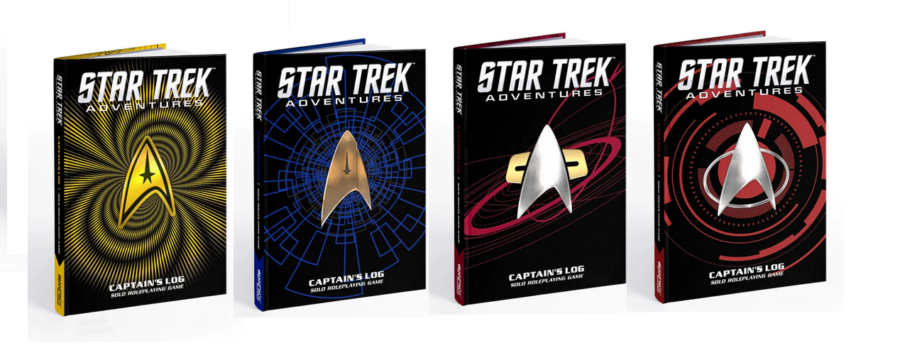
If you’re a TTRPG gamer and have any interest in Star Trek at all, chances are you’ve already heard of Star Trek Adventures, the TTRPG ruleset by Modiphius . We’ve previously covered the Core Rulebook (review here ) and the Lower Decks Campaign Guide (review here ) but it’s time to take a look at one more essential sourcebook for Star Trek Adventures, the Captain’s Log Solo Roleplaying Game !
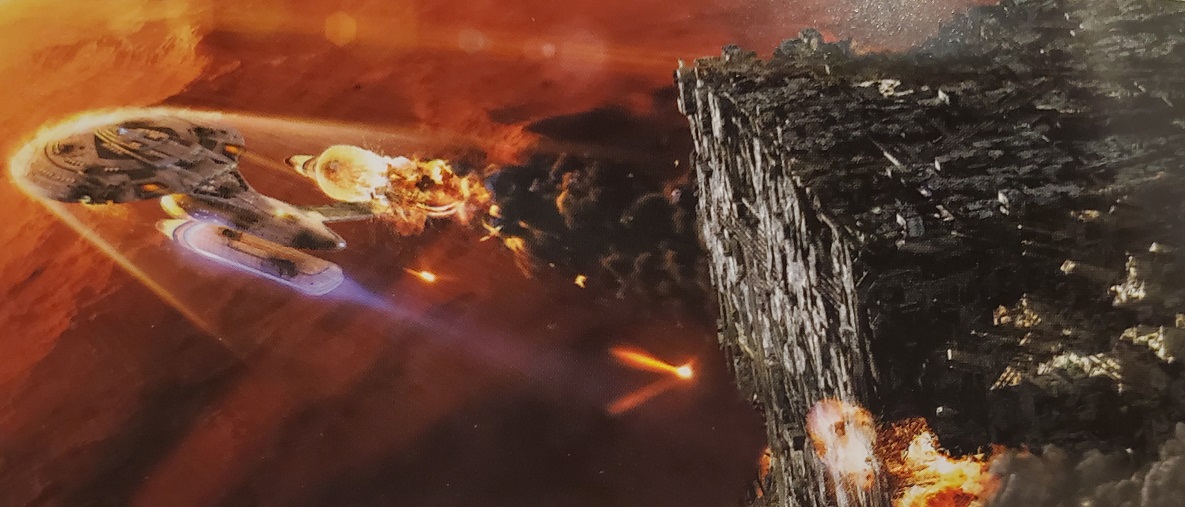
Unlike previous installments of Star Trek Adventures, this volume is dedicated to players that may not have the option to play with others either due to location, scheduling, or other reasons but still love tabletop gaming. To that end, Modiphius has created a resource that allows players to play alone, with another player, or even in small groups and uses the core ruleset of the original Star Trek Adventures TTRPG as a template to do so. If you’re already familiar with the original game, this is a scaled-down version that uses most of the same concepts but rearranges them in such a way that it allows for near-infinite modular redesign of the game based on your individual needs.
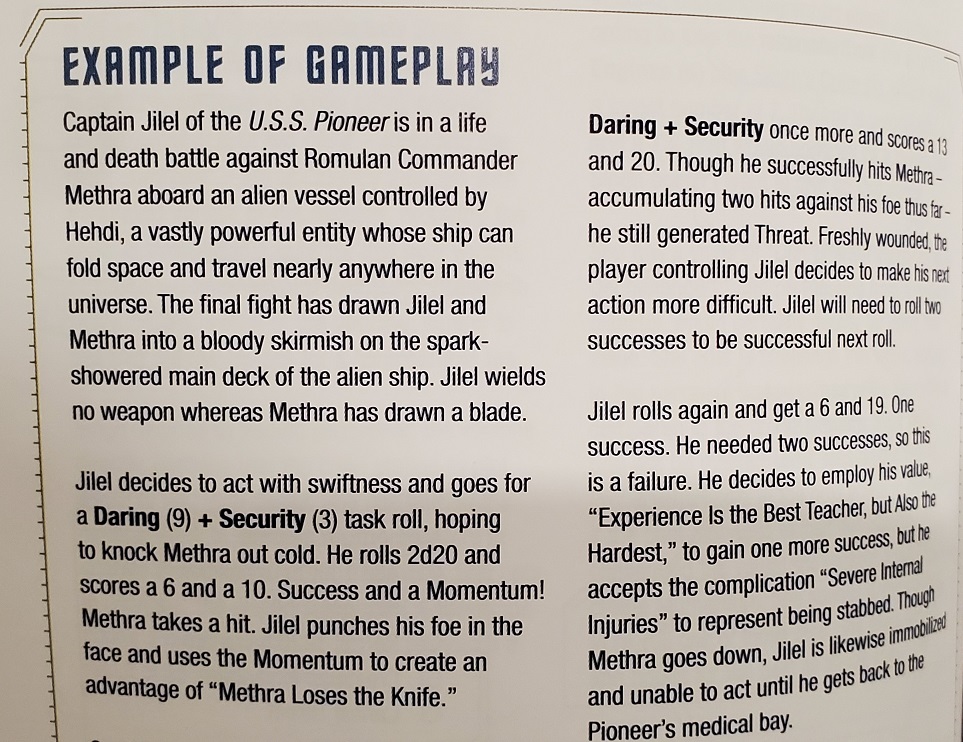
The Captain’s Log is much more than just a simple rules modification of Star Trek Adventures though. It’s a guide to approaching single player gaming, a style guide that helps players and GMs write more interesting adventures, a complex set of matrices and modifiers that enhance gameplay and remove personal bias from game choices, and even a style guide to both writing and screenwriting for beginners and enthusiasts alike. The volume is broken up into six chapters and each chapter has a number of complex sections but you’re not just jumping into gameplay here. There’s a certain amount of background required to play Captain’s Log and it’s provided throughout the book.
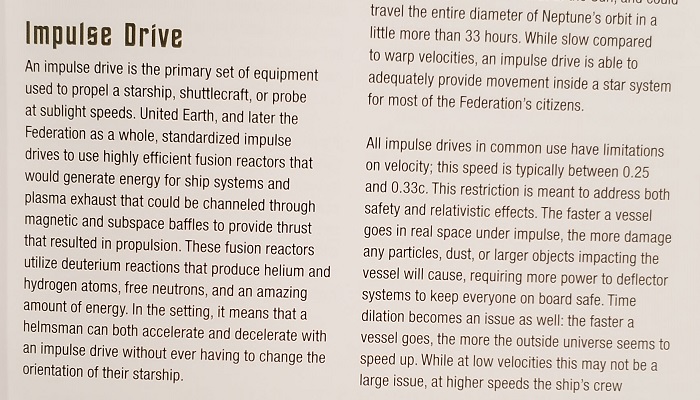
The first two chapters of Captain’s Log serve as background establishment for the Star Trek Universe and establishing your game focus respectively. There is over 60 years worth of content to draw from and condensing all of that into an accessible volume is no easy task. It certainly wouldn’t hurt to have the Core Rulebook as well, but if your goal is solo playing and not exporting characters, you won’t need it as the Captain’s Log is a self-contained volume for the purposes of play. Thinking about how to play and what aspects to focus on when playing alone is a challenge for many players and Chapter 2 does an admirable job of clearing up how to approach Star Trek Adventures from this perspective.
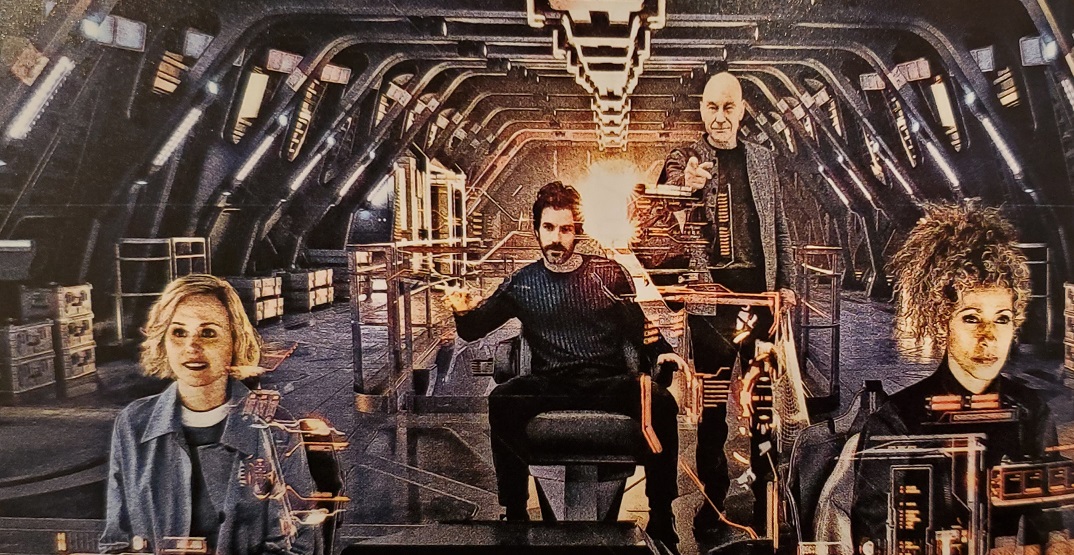
By the time you get to Chapter 3, you should have a thorough grounding in both lore and game concept and it’s time to start building a character. There are two distinct pathways to do this, a roll-as-you-go shorter method that meshes character development with gameplay and a more formal character development process that is time consuming but noticeably more detailed. Either one is fine but the overall approach to gameplay in Captain’s Log favors the roll-as-you-go method a bit more. The idea of having a character that isn’t firmly established and fleshing them out through the course of gameplay that is unpredictable thanks to the matrices you’ll use is certainly appealing. In fact, this is possibly the coolest thing about Captain’s Log. You simply do not know what’s going to happen. With old Choose-Your-Own-Adventure books and single-player gamebooks, you can just fudge the numbers to get the result you want and many of us did. But the Captain’s Log offers a series of complex tables and charts in its appendices that make it more appealing to not know what’s going to happen and as a result, effectively encourages fair play in a way that no single player gaming book has ever done before.
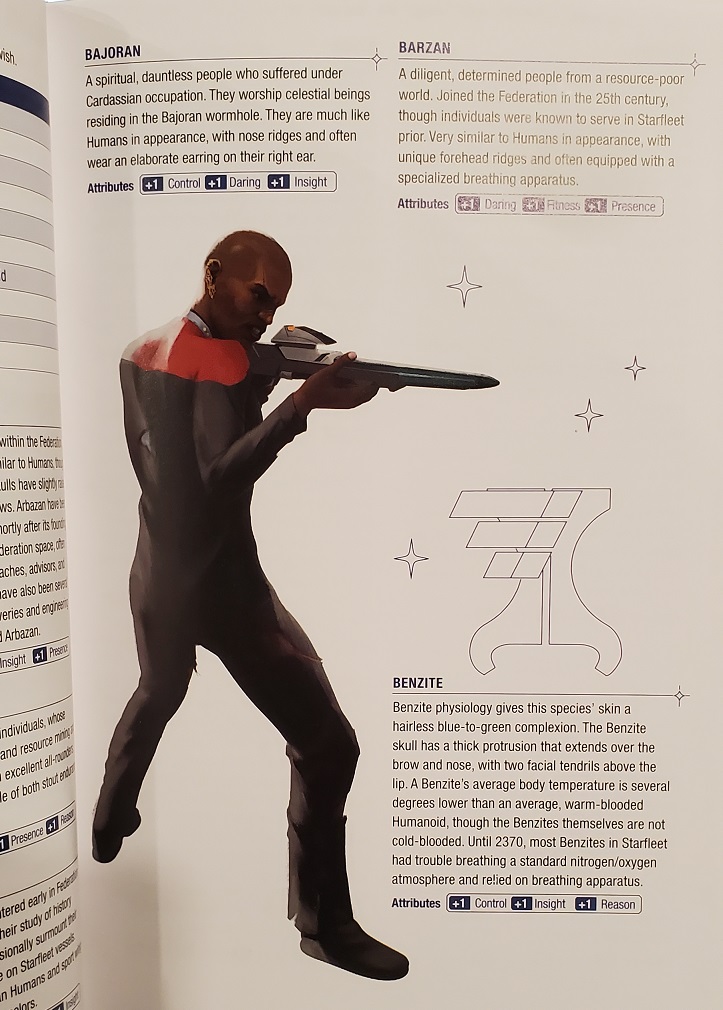
You might end up with a character and backstory you had entirely not considered and your job at that point is to start to try to think like your character in a variety of situations. That’s a challenge that’s both interesting and unpredictable, making for a compelling and immersive experience. You might not even know what ship you’re on or how your character reacts under pressure until the situation arises and you’re forced to reevaluate what you thought you knew on the fly. That’s definitely not the standard recipe for a TTRPG by any means. Species, education, backstory, and even personal moral guiding principles are all considered here and the Captain’s Log has charts, tables, and reference information for every single bit of it. Even different eras of Star Trek are considered and you can choose or roll alternatives based on which era you’ve chosen (or rolled as well).
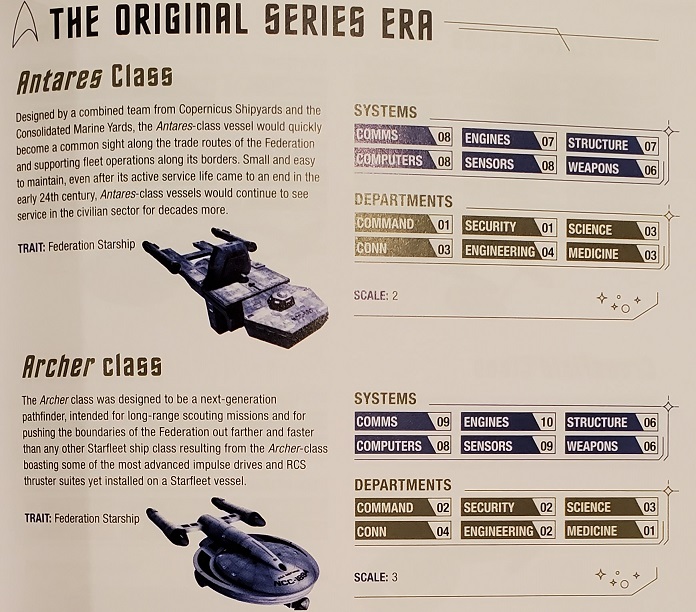
The same can be said of your ship, home base, or station. Everything is on the table in the Captain’s Log and your ship or station can be easily rolled up using 2 D20s. Even starship quirks have been included, allowing for an impressive amount of customization. There’s a simplified listing for every Federation ship, unique ship modifications, and even directions on how to upgrade and choose registry numbers, not to mention expanding things for a starbase. The rules for ships are streamlined from the main Star Trek Adventures rules and are also generally guidelines allowing players a wide degree of latitude. That’s a pretty neat approach and one that takes the pressure off of players who aren’t craving a high degree of complexity. For those that want a more technical approach, the Captain’s Log accounts for inclusion of the main Star Wars Adventures rules at the preference of the player and encourages you to tailor your campaign approach to your personal tastes.
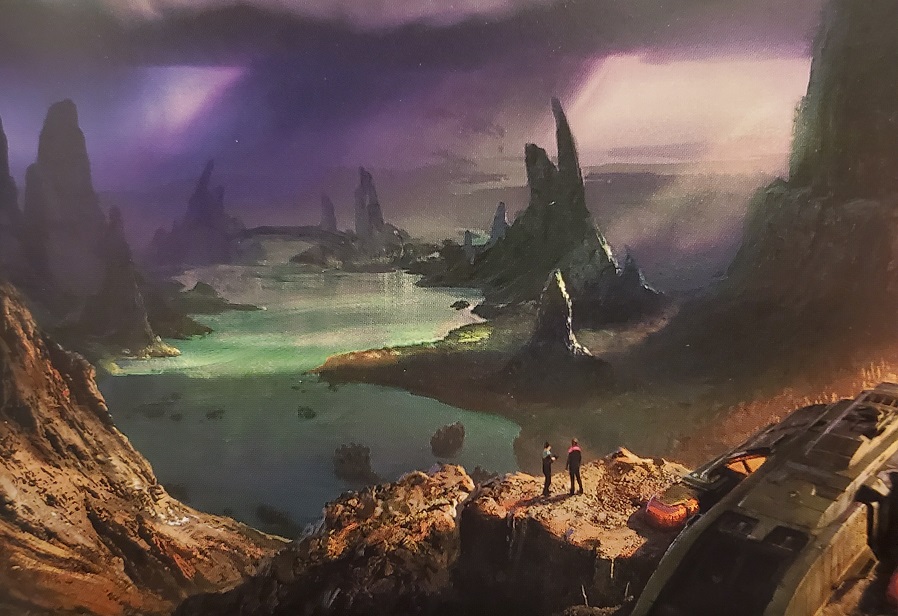
Chapter 5 is where the meat of the game you may have expected to be at the beginning resides. Everything before this was setup and prep work but here we get detailed flow charts of how each portion of gameplay lays out and should proceed. These are detailed examples that really break down the general approach players should take to the narrative structure of the Captain’s Log. These include a tracking system for personal tracking of scene success, how to use probability matrices effectively, plot structure and how to complicate it to make the game more interesting, and how momentum, threat, values and more can be approached during gameplay. There’s also a detailed explanation of combat and ship combat as it pertains to solo gaming in the Star Trek Adventures universe and a series of flow charts and action options for both personal scenes and ship-based ones. Finally the inclusion of collaborative elements is tossed in for good measure, allowing for the expansion of a solo campaign into a slightly larger one that is still modified from the standard game. That’s a lot, right?
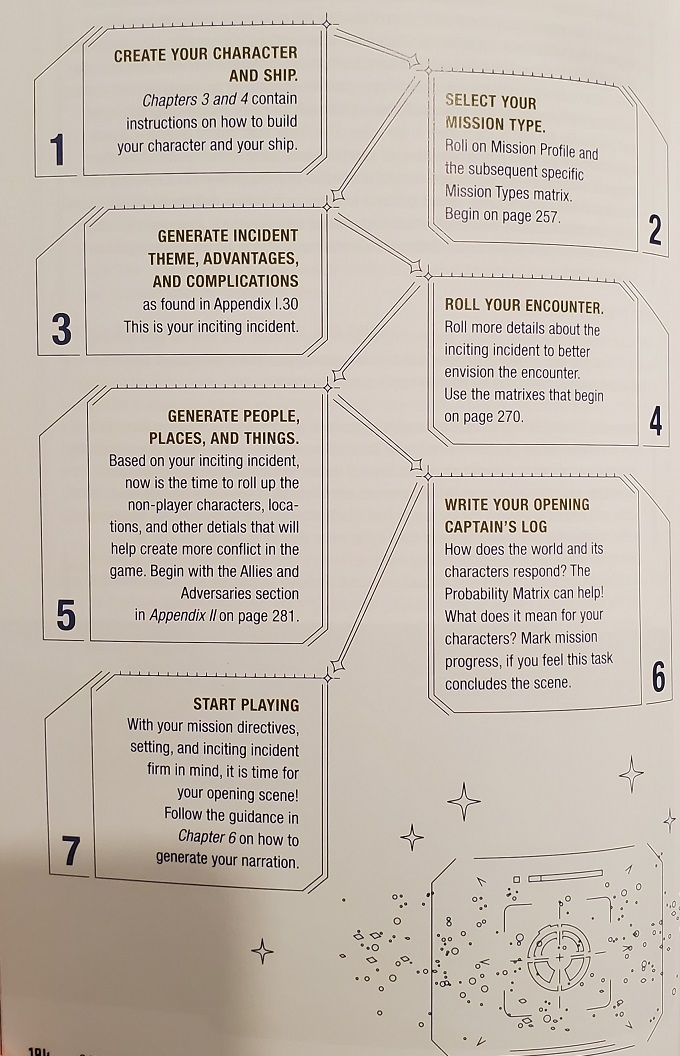
What’s interesting up to this point is that the entirety of the Captain’s Log is focused on immersing you deeply into the lore and storytelling of the Star Trek universe. All the information and development is laid out carefully for you and then once you are thoroughly grounded, the mechanics are clearly and simply distilled. It’s a step-by-step guide that initially looks chaotic and confusing but following through the Captain’s Log clears up almost any misconception a player might have, even with a casual perusal. By the time you get to the final main chapter in the book, you’ll be ready for the most important part of Star Trek Adventures – storytelling.
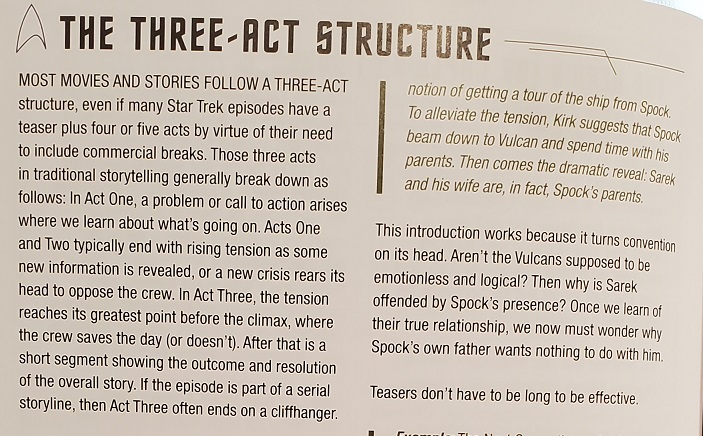
The final main chapter of the Captain’s Log not only lays out how narrative structure and traditional hero’s journeys work but also how you can plan out your story without ruining it for yourself using the tools provided in the book itself. Common screenwriting techniques are explained as they relate to Star Trek and a variety of references to episodes are supplied as well to reinforce the lessons in the volume. The real focus however is on writing a Captain’s Log. Just like in Star Trek, one of the key activities in a solo game is actually chronicling your adventures in a facsimile captain’s log just like the TV series. There are guides to how to write journal entries and supplemental entries, how to structure the gameplay loop, and even how failure can be incorporated into story and character development as a plot device. In short, it’s a condensed Star Trek themed screenwriting course!
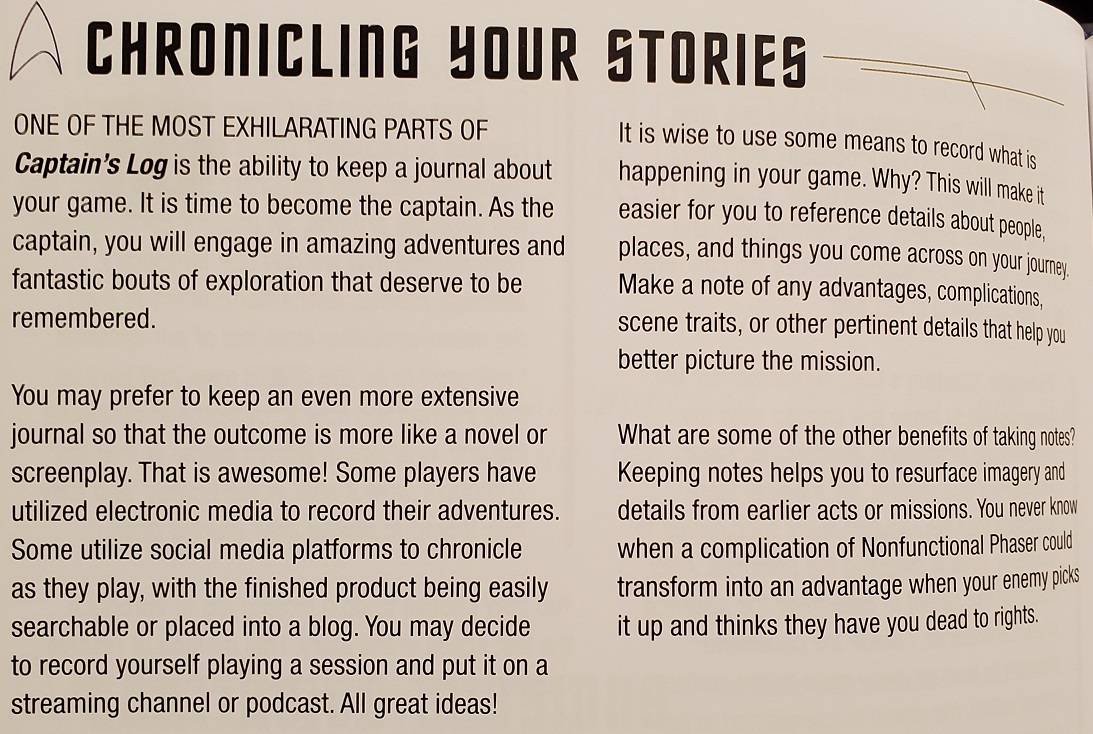
Now if you’re not a writer and you have no desire to write stories down, you could just take bullet points, record your thoughts, or otherwise find an alternative. But write you must in some form as the Captain’s Log approaches the Star Trek TTRPG as a storyline that builds upon previous experience and if you’ve rolled up a bevy of adventures and plan to come back, having that reference will be key and the final storyline will be something that would not look out of place in a lore section of a Star Trek video game or Wiki article. But let’s be honest, this won’t appeal to everyone. Some people just don’t like to write and if that’s you, you’re going to struggle with the Captain’s Log, especially as a solo player.
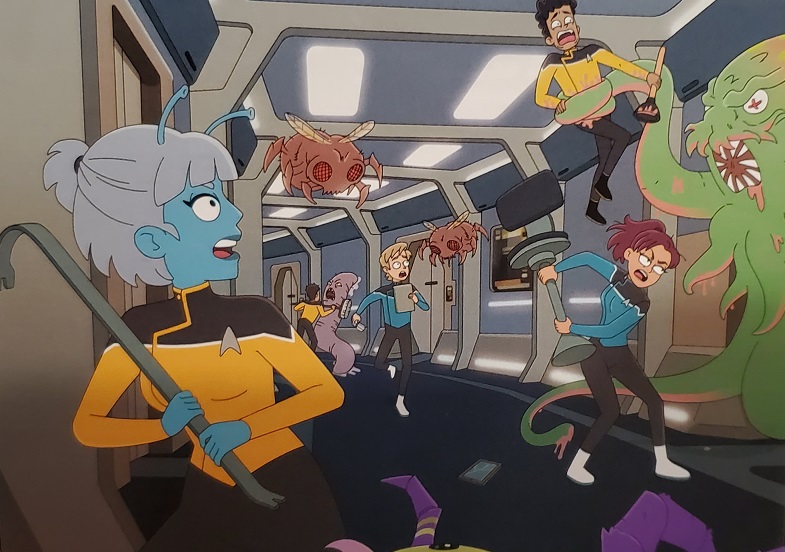
That’s not to say that the Captain’s Log is bad or doesn’t do what it’s supposed to, it absolutely does. But there’s a certain type of person who will thrive under a system like this one and if you’re not creative, it will be a bit of a struggle because the entire game is designed to have you personally serve up a narrative experience that’s less focused on stats and numbers and more focused on excitement and storytelling. That’s a heck of an approach and it makes for some potentially interesting gameplay experiences, especially if you genuinely don’t know where the plot is heading and you’re legitimately using Modiphius’ 2D20 system to make key choices.
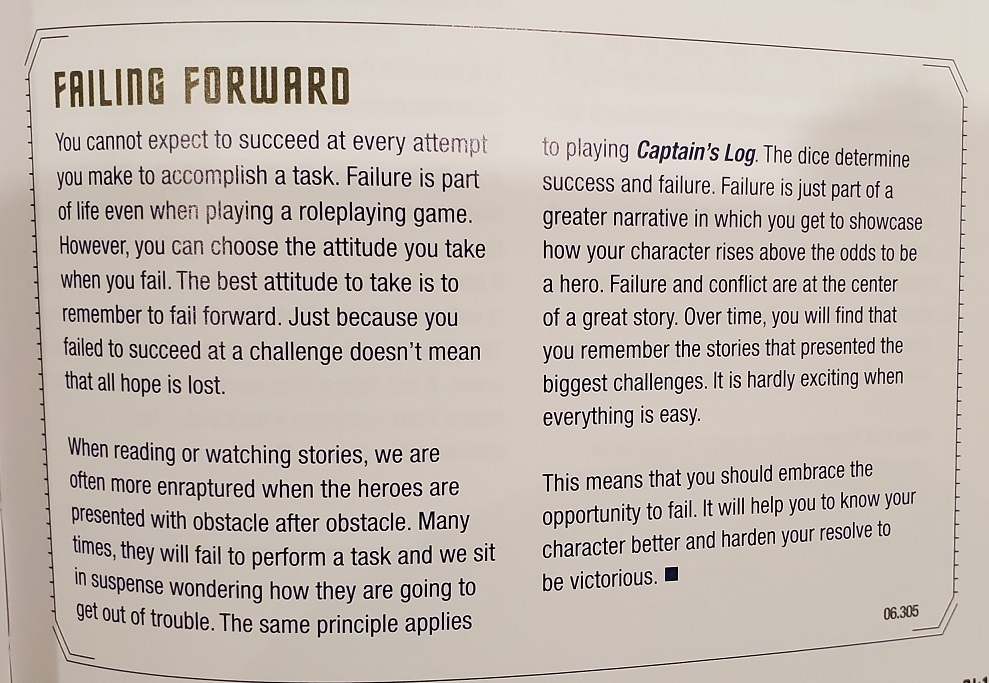
Regardless of your approach, whether it be more detailed or off the cuff, the Captain’s Log is a hell of a well designed system. The entire rest of the book is taken up by a bevy of complex matrices for almost every conceivable need as well as a handy index, some character and ship sheets and some quick reference materials. Everything has been thought of and seen to here and once you learn your way around the pages and bookmark the stuff you need the most, this book will serve as an effective tool that you’ll want to utilize even if you’re not playing solo! Just using the storytelling information and matrix events alone are enough to warrant a purchase of this volume and there’s a lot more besides that here, plus there are different covers for different eras of Trek (though the interiors are the same). Fancy!
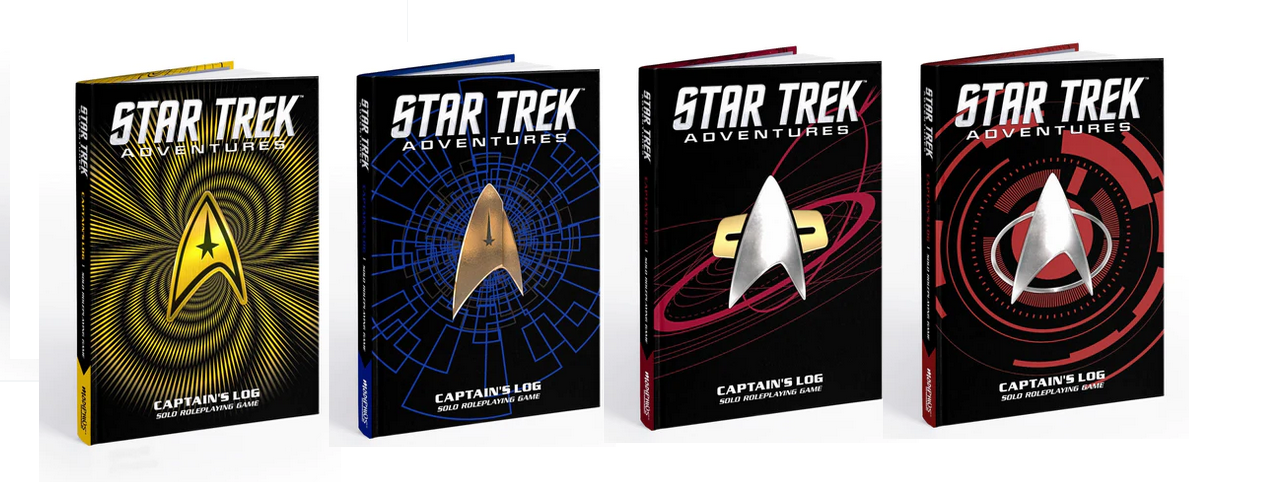
The Star Trek Adventures: Captain’s Log Solo Roleplaying Game is an essential volume for both Gamemasters and players. Not only does it provide an exhaustively detailed slimmed down campaign design schematic for individual players, the training within its pages also has the potential to help Gamemasters refine their approach to narrative storytelling within the Star Trek universe and its versatile handling of various game systems and clear explanations of how to modify them for your personal tastes and needs is simply excellent. This is a a must-have volume for TTRPG gamers in the Star Trek universe and it’s worth every penny of the $40 or so you’ll pay for a physical copy or $20 or so the digital copy will run you. Modiphius has outdone themselves on this one and you won’t want to miss it!
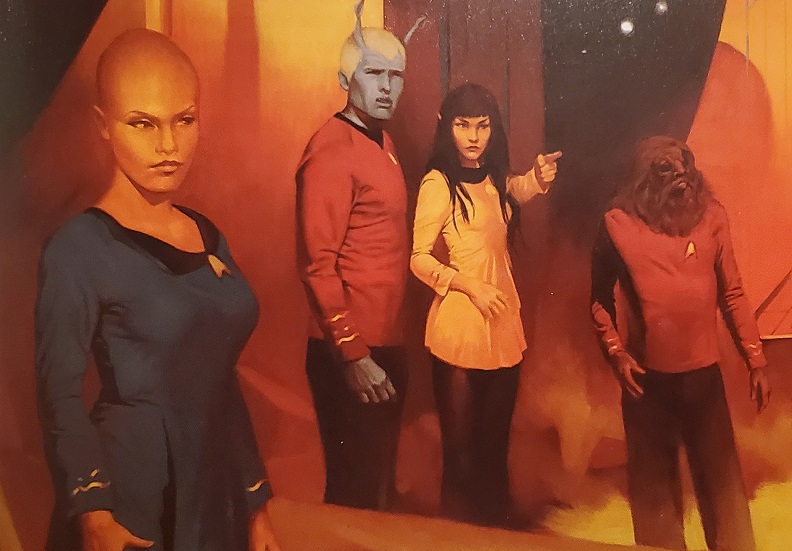
This review is based on a physical copy of Star Trek Adventures: Captain’s Log Solo Roleplaying Game provided by the publisher. It is available directly from Modiphius here and on PDF here , as well as at select fine gaming, book, and TTRPG retailers.

Nate Van Lindt
Nate Van Lindt has been a gamer since the days of yore (aka Commodore 64), and has played a bit of virtually everything out there. He's also an avid comic book collector, both vintage and current, and reads a fair amount of sci-fi and fantasy. On top of that, he watches a fair number of movies and TV shows as well. Oh, and he has a family, a full-time job, and lives somewhere in the urban wilds of Southwestern Ontario, Canada, foraging for old video cables and forgotten game soundtracks.
- Nate Van Lindt https://theotakuauthority.com/author/maxlords/ Touch This! - Touch Detective 3 + The Complete Case Files Review
- Nate Van Lindt https://theotakuauthority.com/author/maxlords/ Death To The King! - Let’s Revolution Review
- Nate Van Lindt https://theotakuauthority.com/author/maxlords/ Are We Ever Truly Alone? - Alone in the Dark Review
- Nate Van Lindt https://theotakuauthority.com/author/maxlords/ A Celebration of Exploration – Rebel Transmute Review
Share this:
Related post, contra: operation galuga review: enough to redeem the series, editorial: five nintendo games that have aged well, feature: four series that wayforward should work on, wrath: aeon of ruin embraces carnage on consoles today, lost legions announced for pc, river city girls 2 adds billy and jimmy lee from double dragon as dlc.
Star Trek Adventures lets you boldly go solo with new Captain’s Log RPG supplement
Solo, not Sulu.
A new addition to the Star Trek Adventures tabletop RPG allows players to explore the universe from the captain’s seat all on their lonesome. The Captain’s Log adapts the rules of the base game into a “streamlined version” suitable for solo play or collaborative adventures.
Publisher Modiphius announced the supplement on July 11th, saying the 326-page rulebook adapts their licensed RPG’s mechanics into a story-driven experience that can focus the camera on characters big and small within the Star Trek’s science fiction world . Better yet, the book is a standalone creation and won’t necessitate also buying the other core titles in order to play.
Players will begin by creating their own character, portraying them as a noble and stalwart StarFleet captain or another, more unassuming member of the crew. The important thing is that the story will focus on their exploits and individual goals, bringing a sense of adventure and wonder along with them.

These stories can play out in any era of Star Trek’s established timeline, and with any starship and crew makeup. Characters will have explicit lifepaths and roles that define their place within the crew, but how they react to the types of situations you might find in an episode of Star Trek is up to the player.
Mudiphius’ in-house 2D20 ruleset - seen in Dune: Adventures in the Imperium and Achtung! Cthulhu - will power the roleplay, using a pair of 20-sided dice to resolve most conflicts and altercations. The book will also contain a cultural primer on the universe of Star Trek and its eclectic cast of alien species. Over 100 included random tables give those with less experience playing tabletop RPGs by themselves plenty of tools for greasing the wheels of imagination - mission themes, how to spend downtime, alien worlds and navigating the friction when worlds and cultures collide.
Though the book is designed for solo play, additional rules will outline how to explore the cosmos with a friend or alongside a facilitator hosting and guiding the events at the table. Fans can choose amongst four special covers inspired by Star Trek’s major eras - original series, The Next Generation, Deep Space Nine & Voyager and Discovery all come with their own distinct cover designs.
Pre-orders for The Captain’s Log are now open on Modiphius’ website , and the publisher said digital PDFs will be available immediately upon purchase. The physical books will begin shipping online orders in August - expect to see it pop up in local game stores at the same time.
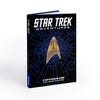
Read this next
- Star Trek Adventures’ Second Edition adds playable Klingons, Romulans and Strange New Worlds this summer
- Pathfinder, Warhammer: Soulbound, Root RPG and more feature in this year’s Free RPG Day
- Star Trek Adventures RPG finally lets you play as a Klingon in new core rulebook

Login to my account
Enter your e-mail and password:
New customer? Create your account
Lost password? Recover password
Recover password
Enter your email:
Remembered your password? Back to login
Create my account
Please fill in the information below:
Already have an account? Login here
Your cart is empty
Introducing Captain’s Log

By Jim Johnson, STA Project Manager Art byline Art by Michele Frigo & CBS Studios Inc.
If you’ve seen the press release about Modiphius Entertainment’s newest Star Trek product, the Captain’s Log Solo Roleplaying Game , you may be wondering: “What is a solo roleplaying game?”
Putting it simply, a solo RPG is a pen-and-paper roleplaying game that can be played by a single player, without the need for other players or a gamemaster. Using the rulebook and components including guidance, story tools, random tables and worksheets, players can unlock the most incredible stories in a solo setting. Some consider solo RPGs a form of guided journaling or tools for creative writing; both are correct..
For Captain’s Log specifically, we’re talking about creating expansive and amazing Star Trek stories, inspired by the franchise’s many incarnations and eras of play. The game’s contents and tools can be used to tell stories inspired by various Star Trek eras, from the earliest days of the Federation in the 2100s to the 32nd century and beyond, and by any Star Trek culture, species, or situation.
You can choose to set your game at the dawn of Earth's tentative steps to exploring space between the 20th and 21st centuries; or move along to the "Five Year Mission" period during the 2200s when illustrious captains like Georgiou, Pike, Kirk and Kang commanded starships that pushed the known boundaries of space exploration; the 2300s when the Klingon Empire and Federation forged peace and had to navigate the challenges that followed; all the way up to the far future depicted in the recent seasons of Star Trek: Discovery . The possibilities truly are endless!
You choose everything about your character! Their species, role, rank, allegiance, gender, skill set and so much more. Whether they are a Human Technician or a Ferengi Commodore, any type of character you can imagine is possible when playing Captain's Log .
You can plan it and play it all by yourself. No need to find a gamemaster or other players to play with – you can play right away, with your favorite beverage and writing tools at hand. You can play at any time and at your own pace! Plan missions centered on Deep Space 9 over a lazy weekend, or take 15 minutes to squeeze in that all important scene for your captain. Captain's Log is ready any time, anywhere for your imagination to go wild and discover all that's possible
Our future posts will delve into more detail on how Captain's Log works, including how to use the tools in the book to create your captain; their starship or space station; how to set up the story you want to tell and so much more!
Brace yourselves for an exciting ride into a bold, new frontier of Star Trek storytelling and roleplaying. I cannot wait to read and see the stories you create with Captain's Log !
Preorder your copy of the Captain’s Log Solo Roleplaying Game now and receive the final PDF right away and start creating your own Star Trek stories!
Thanks for reading this article, and thank you for your interest and support of Star Trek Adventures ! Keep frequencies open for news about Captain’s Log and other Star Trek Adventures product releases. Live long and prosper!
Open Hailing Frequencies
TM & © 2023 CBS Studios Inc. © 2023 Paramount Pictures Corp. STAR TREK and related marks and logos are trademarks of CBS Studios Inc. All Rights Reserved.

Get the latest info on product releases, new sales, and development updates.
100% free, Unsubscribe any time!
- Opens in a new window.
Net Orders Checkout
Shipping address, shipping methods.
- More to Explore
- Series & Movies
Published Jul 11, 2023
Star Trek Adventures to Launch Solo Edition with Captain’s Log Solo Roleplaying Game
Write your own captain’s log with this journaling roleplaying game!
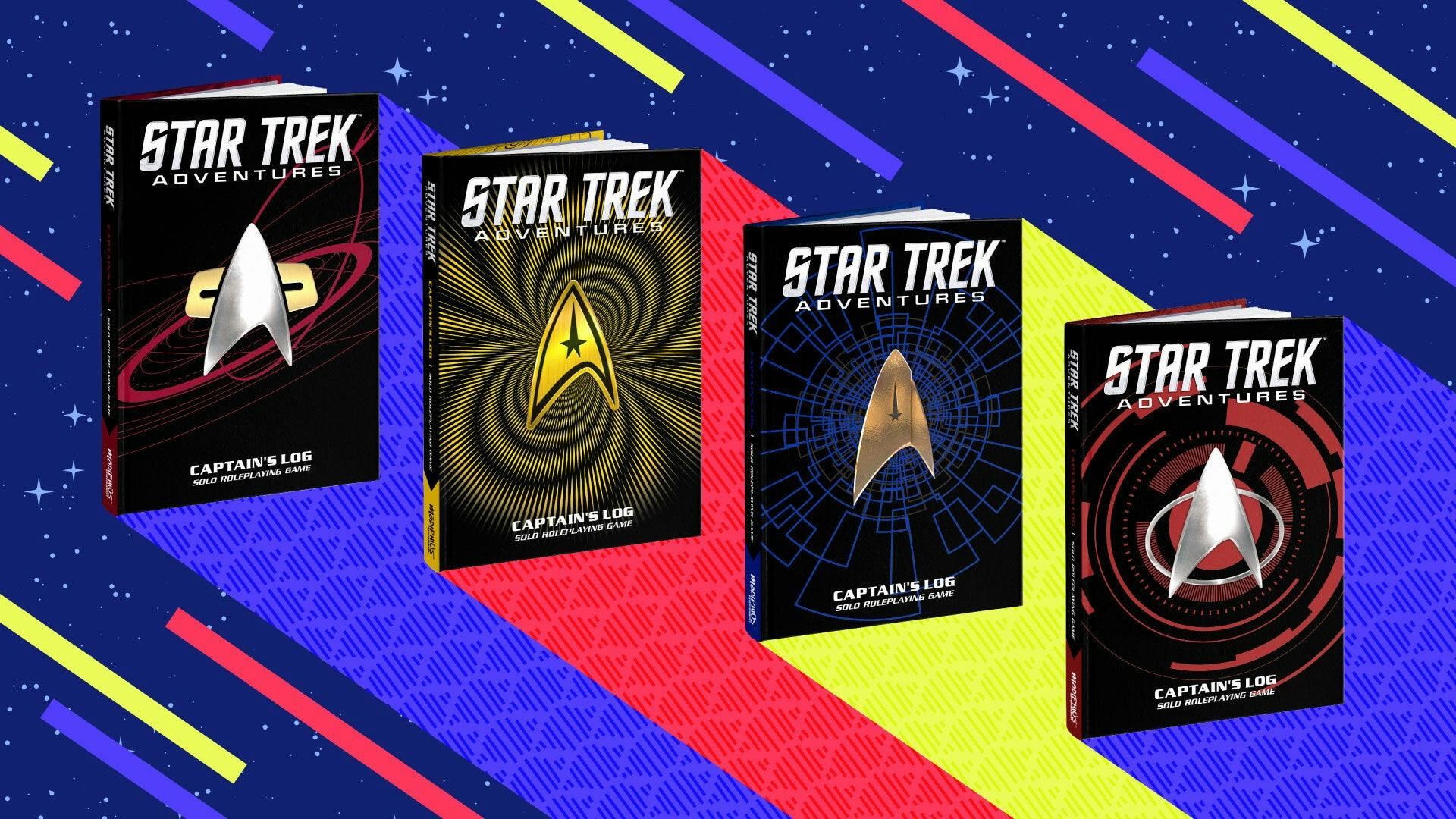
StarTrek.com
Tabletop game publisher Modiphius Entertainment has announced a new Star Trek roleplaying game, launching the brand into the solo roleplaying game frontier, with the Captain’s Log Solo Roleplaying Game .
This 326-page full color standalone digest-sized rulebook provides a complete, streamlined version of the award-winning 2d20 System® used for the Star Trek Adventures roleplaying game to create your own Star Trek stories with a dynamic captain that you create.
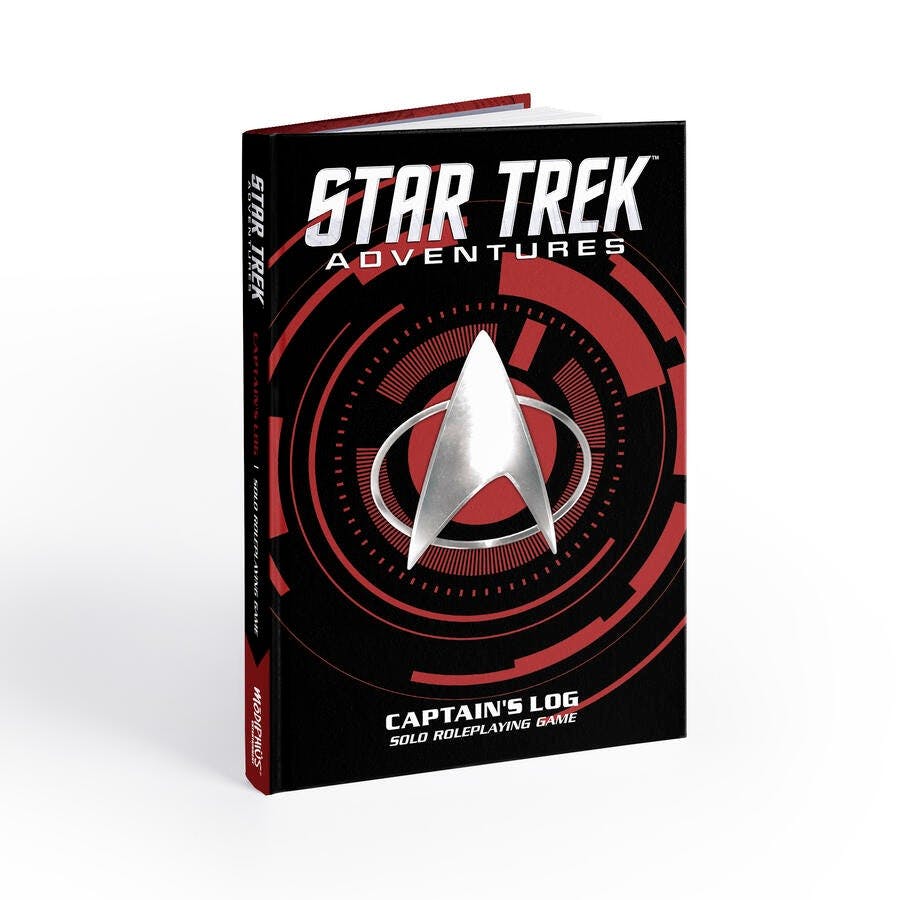
Write your own captain’s log as you, your ship, and your crew venture into the cosmos alone, conducting Galaxy-spanning missions and recording your progress. The solo roleplaying game uses the award-winning rules of Star Trek Adventures to give a unique gameplay style, letting Star Trek fans record their own captain’s logs for the first time!

Players can create or randomly generate their missions without a gamemaster, decide on the actions their crew will take to complete it, and a vibrant story will emerge as success or failure provides unexpected twists and turns while exploring strange new worlds and discovering new life and civilizations. The game also allows captains to play cooperatively with friends as their senior staff, or explore the final frontier with a gamemaster facilitating their adventures. Gamemasters of Star Trek Adventures can also use the random story tables contained in Captain’s Log to generate countless hours of memorable adventures in the Star Trek universe.
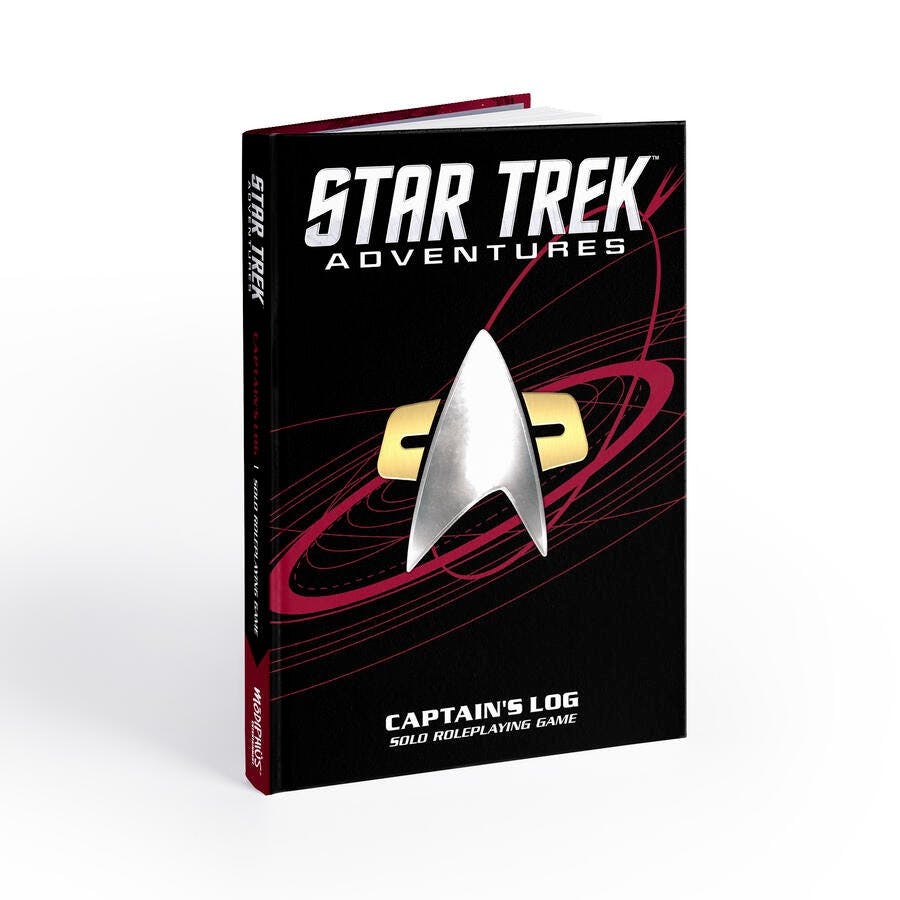
Play in any era of Star Trek , from the 21st Century to the 32nd Century, by choosing from a selection of unique cover designs featuring the combadges from each series.
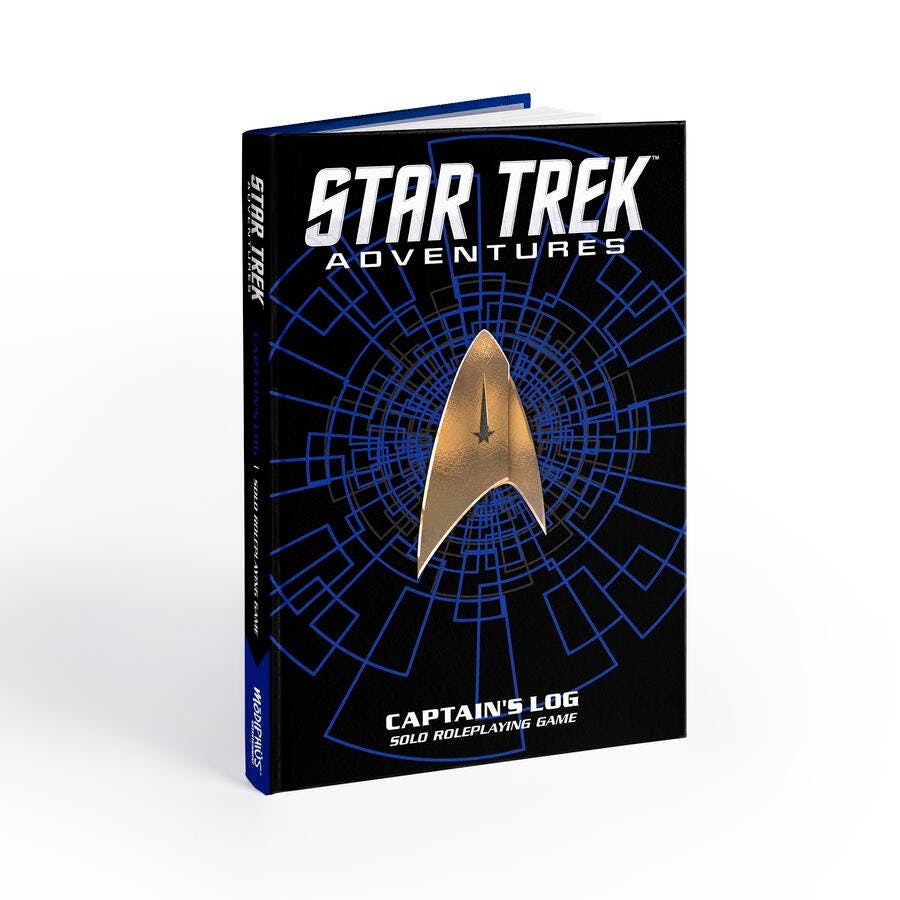
Thanks to our friends at Modiphius, we can preview Captain's Log below:

Prospective Starfleet captains can pre-order copies now from www.modiphius.net or www.modiphius.us and receive a digital PDF copy right away, with print editions expected to ship to stores in August 2023.
Stay tuned to StarTrek.com for more details! And be sure to follow @StarTrek on Facebook , Twitter , and Instagram .
Get Updates By Email

- Christmas 2022
- Christmas 2021
- Movies & TV
- Digital Home
- How To’s & Guides
- Windows Home Server
- Storage & NAS
- Tablets & Slates

The Captain’s Log Solo Roleplaying Game is a 326-page, full-color standalone digest-sized rulebook that provides a complete, streamlined version of the award-winning 2d20 System used for the Star Trek Adventures roleplaying game, which you can use to create your own Star Trek stories with a dynamic character formed from your own imagination.
Whether you are venturing into the cosmos alone, conducting Galaxy-spanning missions cooperatively with friends, or exploring the unknown with a gamemaster facilitating your adventures, use the guidance and random tables contained in Captain’s Log to generate countless hours of memorable adventures in the Star Trek universe.
Create an original character and then use the tools in this book, combined with your fertile imagination, to fashion your own fascinating Star Trek -style stories. Play in any era of Star Trek – from the 21st century to the 32nd century and everything in between. Explore strange new worlds, new civilizations, and all the wonders of the universe!

What will you discover while exploring the final frontier?
The 326-page, full-colour digest-sized hardcover Captain’s Log Solo Roleplaying Game features:
- A streamlined 2d20 ruleset that enables countless ways to play.
- Lifepaths and roles for any type of character, not just Starfleet captains.
- Story-driven solo gameplay that promotes drama in a safe space.
- A Star Trek primer including society, technology, and eras of play.
- Rules for creating or randomizing your own starship or starbase.
- Options to play the game solo, collaboratively with friends without a gamemaster, or collaboratively with a gamemaster
- Guidance on implementing the rules and telling your own stories.
- Over 100 random tables and storytelling matrixes usable in all kinds of games,
- including alien worlds and polities, allies and enemies, mission themes, maintenance downtime, and so much more!
- Available in four different covers inspired by your favorite Star Trek eras: the original series, The Next Generation , Deep Space Nine/Voyager , and Discovery . The interior content is the same for each version.
This was a lot of fun, and as a long-time Star Trek fan I really enjoyed immersing myself into this. I cant wait to try some of the other offerings from Modiphuis.
Star Trek Adventures: Captain’s Log Solo Roleplaying Game is available now priced around £30. Which one will you get?
You can learn more from the Modiphius website.
Stay connected
Latest reviews, review: the kindeman remedy, review: amnesia: the bunker, review: sticky business, review: yoshi’s crafted world, review: kingsgrave, review: call of duty: warzone mobile, you might also like related recommended to you, spider-man: across the spider-verse – live in concert.
© 2007-2024 Movies Games and Tech
- Contests and Giveaways
- Terms of Use
- Competition Ts & Cs
- Privacy Policy
Discover more from Movies Games and Tech
Subscribe now to keep reading and get access to the full archive.
Continue reading
Geek Native
From the land of Geek
Starlogs: A review of a free to download solo RPG/framework for Star Trek RPGs
August 19, 2021 by Andrew Girdwood Leave a Comment 💰 Ads: Links may earn us money
Whether you want to play Star Trek Adventures from Modiphius or the free to download World of Dungeons-based Phasers + Photons you’ll be frustrated without both a GM and a gaming group.
So, Qwo has a solution in the form of the free to download Starlogs . It’s a framework for solo play.
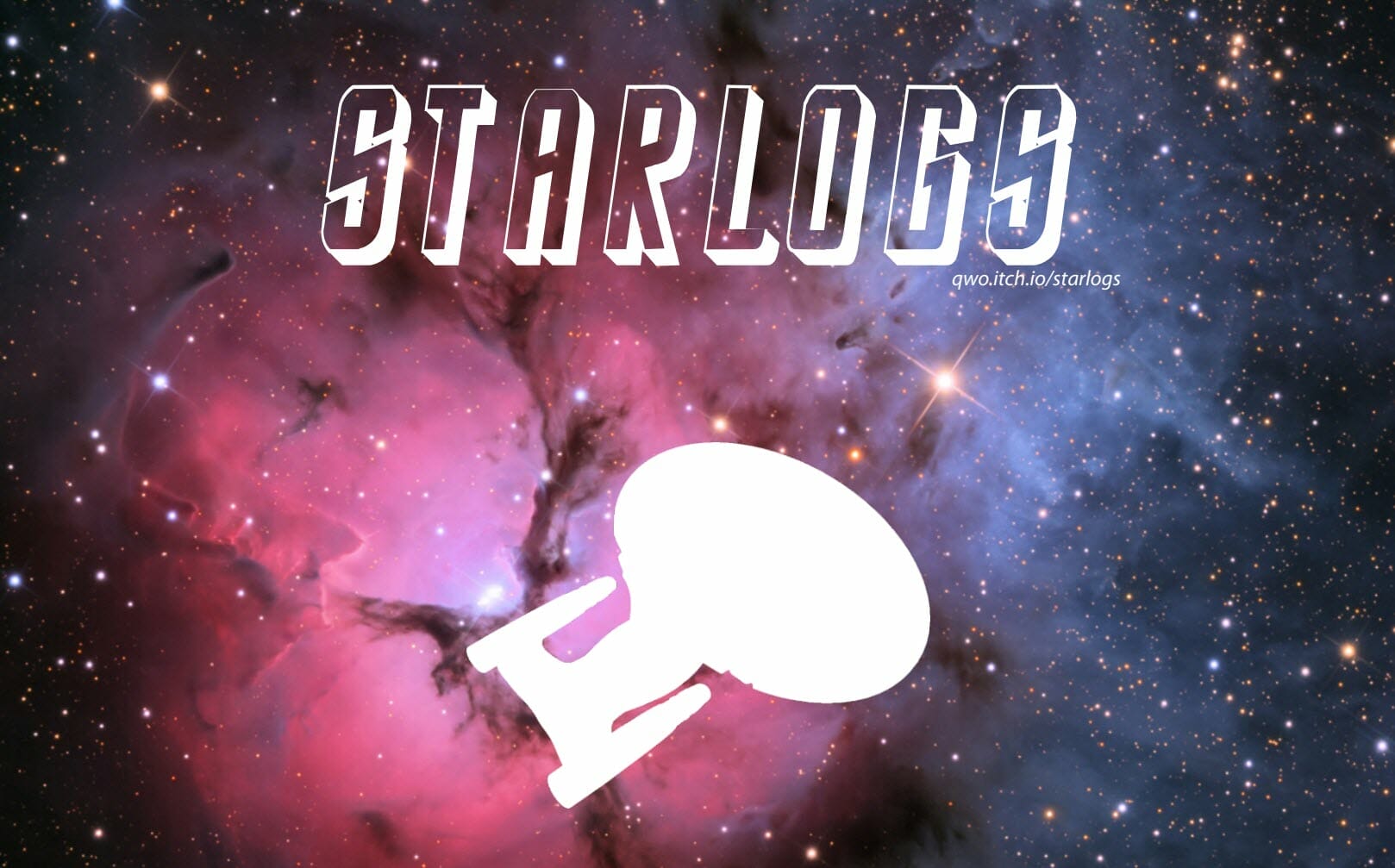
I know, I’ve just mentioned two freebies; Phasers + Photons and Starlogs . Both are by Qwo, so if you’re a sci-fi RPG fan then they might well be worth following on Itch.io.
Starlogs is a generous 24 pages long for a freebie. It’s not quite a full RPG if you’re looking for a traditional game engine, but if you have your own house system, then you won’t need one. Otherwise, Starlogs is best thought of as a framework.
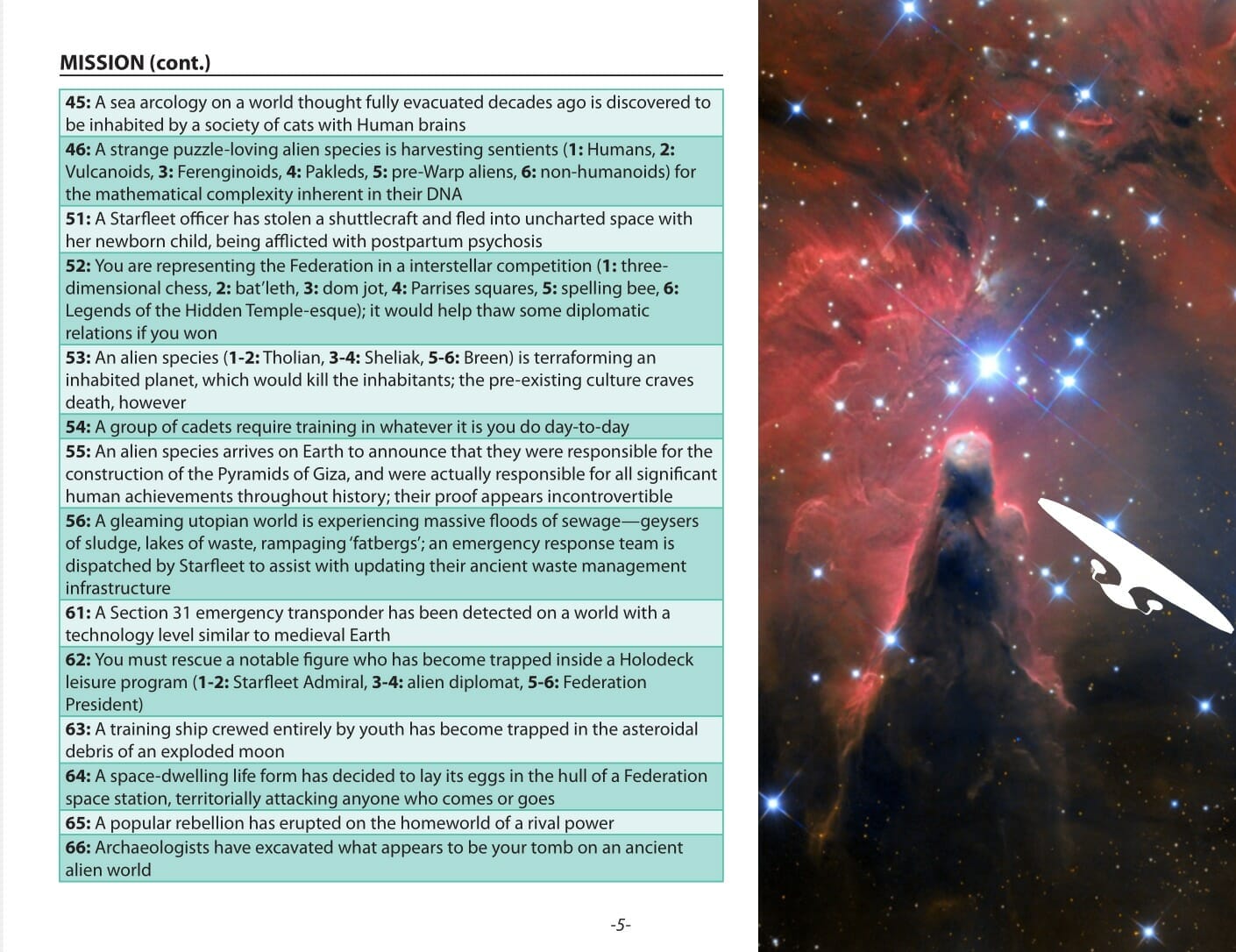
The concept of “automatic episode” is put to excellent use and is easy to learn. The core concepts stretch only a few pages. The rest of the download isn’t filler; it’s handy tables for NPCs, locations and events.
Using Starlogs
Begin with a mission.
Set the scene, either through your imagination, a table here or a pre-written scenario for a Star Trek or other sci-fi RPG that you’re trying to solo.
Then, control your character and have them do whatever makes in-character sense. Starlog’s Probability Matrix will tell you how NPCs react.
You will also check the Probability Matrix whenever details are uncertain.
Each episode is divided into scenes, as RPG scenarios tend to be, and in Starlogs framework, you progress through scene, after scene, at your own place and setting the scene each time.
If your character fails, or you’re not certain what happens next, then there’s a “Complications!”. That’s another roll on a Starlogs table to determine the incoming curveball. Once you’ve done this six times, there’s an escalation, and you start adding +1 to these rolls.
Alternatively, but only once per episode, you can take a “B-Story”. If you complete that, then all future “Complications!” rolls are also made at +1.
You’re done once the mission has concluded, either in success or failure.
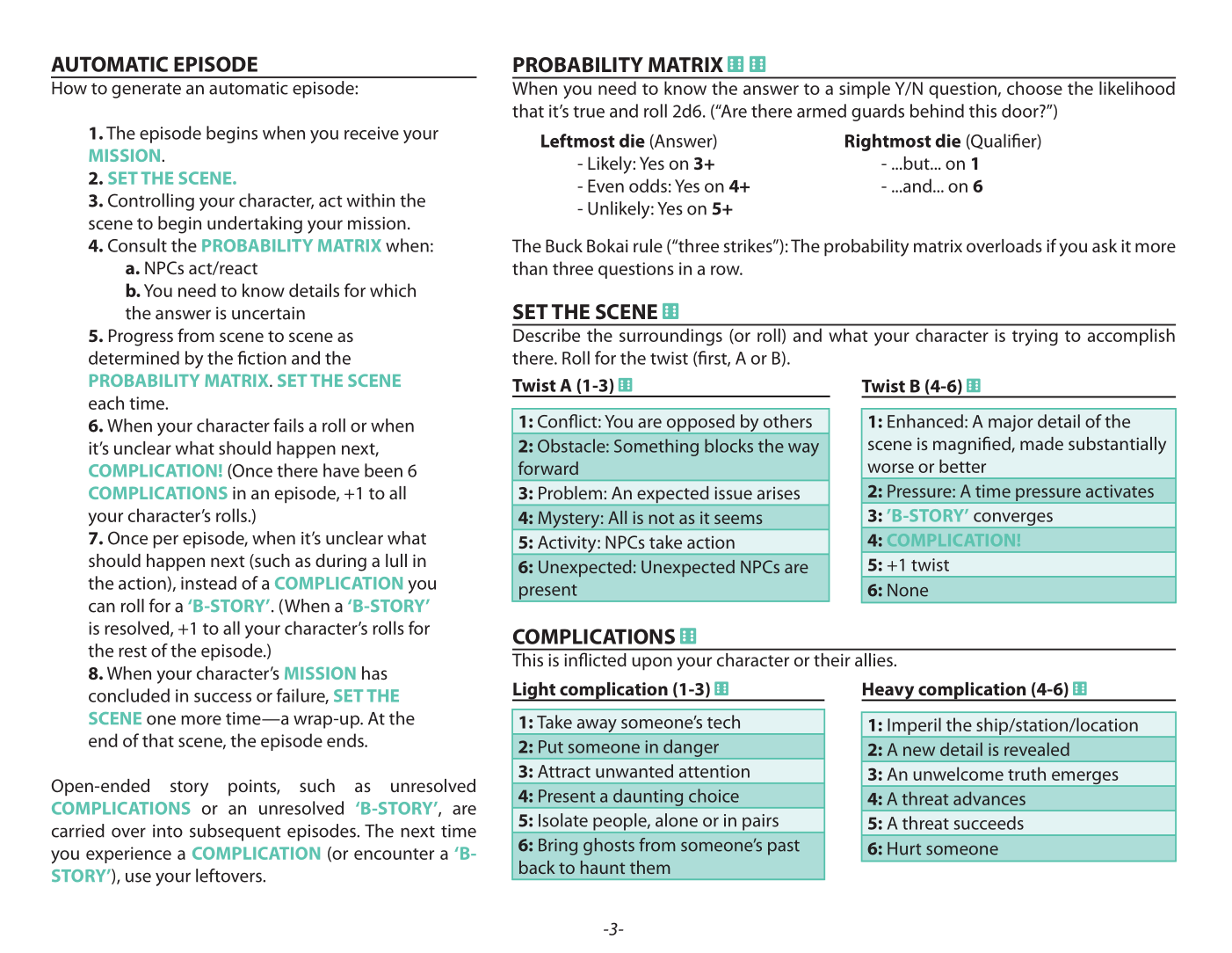
I can’t fault Starlogs. It’s free!
What would make the framework better? More of the same; we could expand all the tables and cross-link them more (such as B-Stories triggering other generators or alien race generators starting a chance of reoccurring NPCs).
I think downloading a copy of Starlogs is a no-brainer. Even if you don’t imagine you’ll be soloing any time in the future, you can use Starlogs for GM or even PC background inspiration.

Quick Links
Geek Native welcomes thoughtful comments from our favourite readers. Join in below.
Explore these posts
- Advertising Disclaimer : As an Amazon Associate I earn from qualifying purchases. Geek Native also earns money through DriveThruRPG and Skimlinks. Find out how .
- Teleport Link: There are people chatting on this article . Join in!
This site uses Akismet to reduce spam. Learn how your comment data is processed .
- Corrections
- Quick RPG news summaries
- Quick mini-reviews
- Quick highlights podcast
- Recent Kickstarters
- Competitions!
Recent Posts
- New Fallout statue of The Ghoul from Dark Horse now available to pre-order
- I can kill so I’ll kill billions: Maggot Machine is a TTRPG in a lost world
- PocketQuest: The Heist Episode – the RPG that steals?

To provide the best experiences, we and our partners use technologies like cookies to store and/or access device information. Consenting to these technologies will allow us and our partners to process personal data such as browsing behavior or unique IDs on this site and show (non-) personalized ads. Not consenting or withdrawing consent, may adversely affect certain features and functions.
Click below to consent to the above or make granular choices. Your choices will be applied to this site only. You can change your settings at any time, including withdrawing your consent, by using the toggles on the Cookie Policy, or by clicking on the manage consent button at the bottom of the screen.

- Login / Register
- Join Our Newsletter
- Miniature Wargames Magazine
- Tabletop Gaming Magazine
- Games Store
- Advent Calendar
- Mystery Boxes
- The Best Games Of
- Subscriptions
- Back A Game
- Playtesting
- Indie RPG Book Club
Star Trek Adventures RPG review
Latest posts.


Vecna Returns for D&D with Vecna: Eve of Ruin
16 april 2024.

To boldly roll where no-one has rolled before
In Star Trek Adventures, Modiphius has come up with probably the best way to recreate the feel of the iconic TV show at the tabletop – no mean feat considering the many ways in which Star Trek differs from other sci-fi settings.
After all, while they certainly had lasers, tentacled monsters and everything else needed to keep things exciting, the episodes' focus rarely fell on explosions as much as diplomacy, exploration and science – even if that last one amounted to little more than babbling about deflector dishes and neutrino beams.
This is reflected neatly in Star Trek Adventures; while there are extensive rules for combat, they aren’t the focus by any means. Exploration and diplomacy are just as important as shootouts, brawls and ship-to-ship engagements, with an entire chapter dedicated to solving problems through futuristic science.
Indeed, Modiphius has made a real attempt to replicate the approach of the show and accommodate the various spanners the format would throw into the works of a more typical RPG. For example, a player taking the role of the chief engineer as their primary character can hop into the shoes of a literal redshirt for missions where there’s more call for steady aim than technical skill, allowing everyone to participate without having to contrive a reason for the entire command crew to take on every excursion.
Beyond this, the impressive breadth of systems on offer means that it’s possible to reproduce virtually every aspect of a Star Trek episode, whether you’re romping around with alien princesses pulled from The Original Series or confronting the ethical dilemmas posed by the Borg or Dominion. However, this does come with a few downsides.
While a typical check in the game will have relatively simple core mechanics – roll a few d20s, then gain successes for each one that comes in under a value determined by your character’s attributes and skills – there are a number of extra systems bolted on that can muddy up an otherwise simple interaction. None of them are particularly unwieldy on their own, but that hardly matters when they stack up so quickly.
Opening a locked door can require management of momentum and threat counters, a complication range, advantages and disadvantage traits, and a few others depending on the exact nature of the situation. All this can sometimes slow the pace of the game to a crawl, with the need for both players and the GM to be highly focused and extremely familiar with the rules to keep things zipping along.
Still, even if you do need to keep the rulebook on hand, you probably won’t mind all that much. It’s a genuinely lovely piece of work, crafted with obvious reverence for the Star Trek universe.
The background and setting sections are incredible primers for the universe and are enjoyable to read entirely independent of the rules – the section on how each class of Starfleet vessel is designed is a favourite. There’s a wealth of information on offer, supported by countless extracts from in-universe reports, letters and logs. Much of the art is exceptional and does a good job of showing everything from the campy pulp of space castles to the clean curves of Federation starships.
Ultimately, this highlights perhaps the game’s greatest strength and weakness. Most RPGs licensed from major properties are relatively streamlined affairs that try not to burden more casual gamers with too many complications but, for better or worse, Star Trek Adventures doesn’t seem to share these concerns.
For some this will be off-putting, but if you’re familiar with both crunch-heavy RPGs and 3D chess, it may well be just what you’re looking for.
RICHARD JANSEN-PARKES
Buy your copy here.
An incredibly wide-ranging ruleset with plenty of options for exploring strange new worlds and seeking out new life and new civilisations, but probably not an ideal first step into the world of tabletop RPGs.
Publisher: Modiphius
Price: £44.99
Players: 2+
Website: modiphius.com
This review originally appeared in the October/November 2017 issue of Tabletop Gaming. Pick up the latest issue of the UK's fastest-growing gaming magazine in print or digital here – or subscribe to make sure you never miss another issue .
Sometimes we may include links to online retailers, from which we might receive a commission if you make a purchase. Affiliate links do not influence editorial coverage and will only be used when covering relevant products.
Login or register to add a comment
No comments
- Writer Sign Up
Blogcritics The critical lens on today's culture & entertainment

RPG Game Review: ‘Star Trek Adventures: Captain’s Log’ from Modiphius
Jeff Provine August 30, 2023 Comments Off on RPG Game Review: ‘Star Trek Adventures: Captain’s Log’ from Modiphius 862 Views
Modiphius Entertainment’s Star Trek Adventures brought new life to the classic universe, with even a special edition for the Lower Decks series . Now Star Trek Adventures: Captain’s Log Solo Roleplaying Game engages players in a tabletop roleplaying game with streamlined gameplay and abundant background material.
The full Star Trek Adventures game requires a narrator and rigorous gameplay, so for players who want to venture out alone or with a ragtag crew, Captain’s Log is the next generation of roleplaying.
Captain’s Log uses trimmed-down mechanics to maximize gameplay so players don’t have to worry much about the nitty-gritty. The goal is storytelling, which fits perfectly in an IP that has existed as television, movies, novels, and comics for decades.
Other tabletop Star Trek roleplaying games have involved intricate statistical systems, but Captain’s Log focuses on the character aspect, with character sheets. Players will spend most of their time working on backgrounds and values for their characters. There are points allocated for different Attributes, including Control, Daring, and Insight, as well as Disciplines like Command, Engineering, and Security. But these are meant to drive the story.
Whenever a player comes into an uncertain situation, they make a single roll against their own skills. For example, a player might add their Fitness and Security for a classic double-fisted punch, and to succeed must roll under that number. The higher the numbers, the easier the success; the lower the numbers, the more likely the failure. After the roll, the story keeps going. The system does not even include hit points, instead detailing injuries that could affect the plot.

With its simplified rolling, much of the flow of the game comes from story structure. Players may design their own missions or roll for a Mission Profile using matrices and tables to determine themes, locations, complications, and an inciting incident. From there, the game’s mission is played out on the model of a story with scenes answering each story question, acts with bigger twists, and rising tension until the explosive conclusion. Along the way, further tables help randomize the mission, but the adventure is wholly up to the player.
Across the Universe
In addition to its rules system, Captain’s Log presents a solid background into the Star Trek world. Even if a player had never seen a Star Trek anything before, the first few chapters give a thorough explanation of the universe in its various time periods, from humanity’s first steps into the stars to the violent wars with Klingons and the Dominion to the darker days of the 32nd Century.
Just the same, seasoned veteran Trekkers will likely learn something new, especially in the chapters on protocols and procedures within Starfleet. The Captain’s Log book also dedicates plenty of space to different kinds of ships in the eras of Star Trek , since, as Gene Roddenberry said, “The ship is not just a vehicle.” No one knows that better than a captain.
Maximum Flexibility
While Captain’s Log is designed primarily for a player to have a Starfleet captain as the primary character, the game proves to be endlessly versatile. Players can design their characters with flexibility not only in their species or background but in what rank they hold, or even if they are in Starfleet at all. Missions can be dangerous deep-space explorations, diplomacy on a Starbase, or slice-of-life adventures with recurring secondary characters for plenty of laughs. With its slim set of rules, the game can be readily adapted to include multiple players in shared storytelling or even to have one player as the traditional narrator. Rules even translate characters between Captain’s Log and the Star Trek Adventures game for special cameos at the gaming table.
Star Trek Adventures: Captain’s Log Solo Roleplaying Game proves that there’s plenty of space in the galaxy, and we can play however we want in it.
Tags Captain's Log modiphius rpg rpg game Star Trek Star Trek Adventures Star Trek Game
About Jeff Provine
Related Articles

Board Game Review: ‘Monopoly Scrabble’ from Winning Moves

Music Reviews: The Doors Live in Sweden in 1968, plus Gene Clark; Richard, Cam & Bert; and the Flying Burrito Brothers

GalaxyCon Richmond: ‘Stand and Deliver’ Stars Edward James Olmos and Lou Diamond Phillips

GalaxyCon Richmond: Brent Spiner on Playing Data in ‘Star Trek: Picard’ and More
"There wasn't a real precedent on how you play an android."

- console.error('Error sharing:', error)); } else { navigator.clipboard.writeText('https://thepopinsider.com/star-trek-adventures-captains-log-rpg/').then(() => { console.log('Link copied to clipboard'); alert('URL copied to clipboard'); }).catch((error) => { console.error('Error copying link to clipboard:', error); }); } return false;" aria-label="Share share" > share
Explore the Final Frontier Solo in New Star Trek Adventures: Captain’s Log RPG
Take on the challenges of a Starfleet captain in Modiphius Entertainment’s new solo roleplaying game.
- twitter Link to Twitter
- linkedin Link to Linkedin
- instagram Link to Instagram
- facebook Link to Facebook
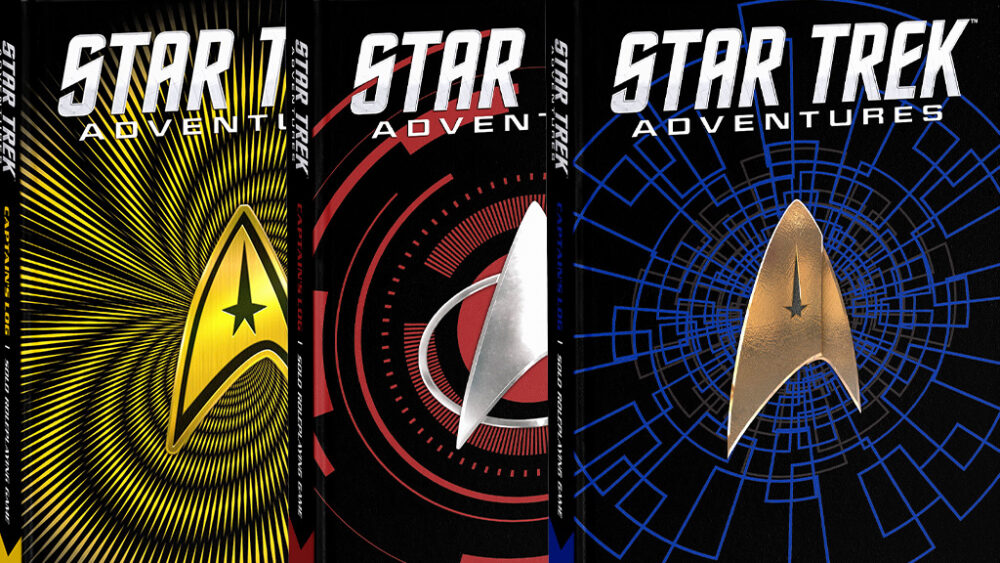
Live long and prosper, and have plenty of roleplaying fun — even when you can’t get your group together!
Modiphius Entertainment is known for offering tabletop roleplaying games inspired by all sorts of pop culture favorites. The company already offers Star Trek Adventures, a game in which Star Trek fans can fully immerse themselves in the world of their favorite series. Now, the company making sure Trekkies can explore space solo with the Star Trek Adventures: Captain’s Log Solo Roleplaying Game.
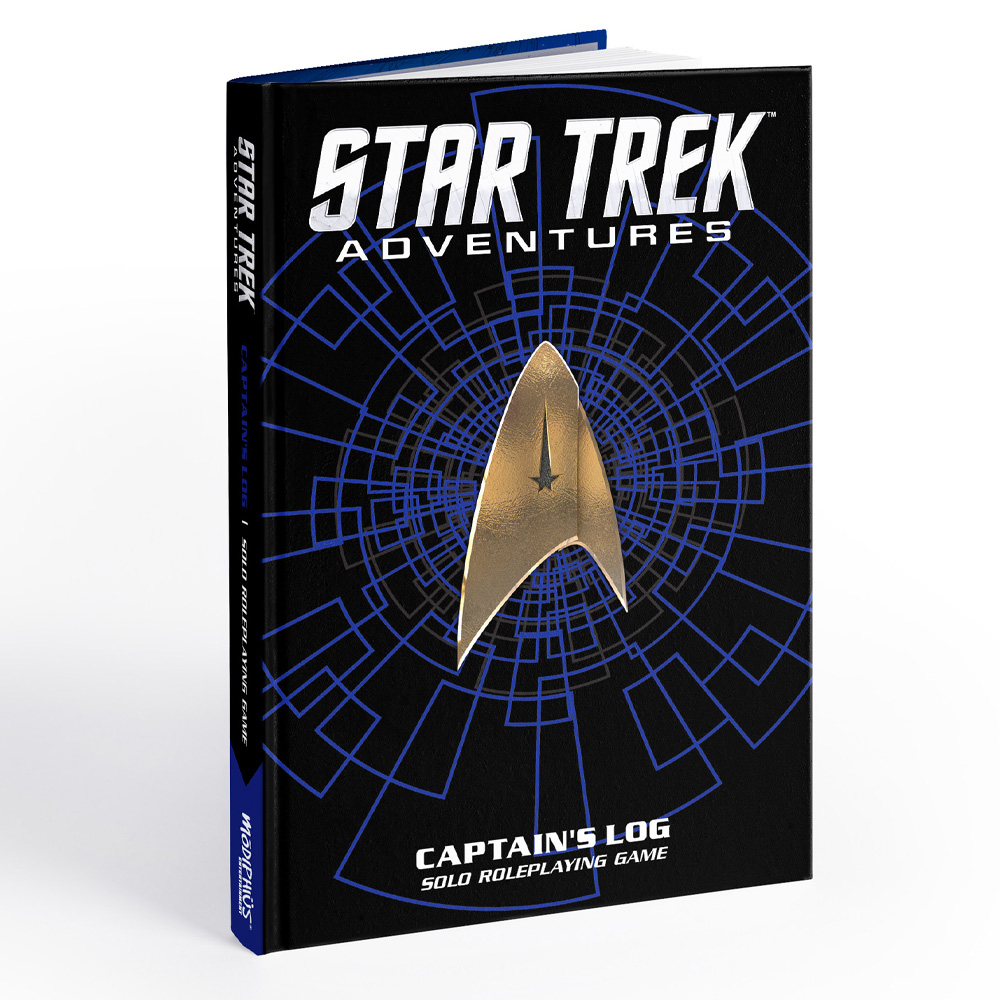
The new game is a 326-page standalone rulebook that guides players through creating a character and playing out their story. Players can play alone, with friends collaboratively, or with a gamemaster running things, which means it’s a perfect option for any game night. Fans can choose their experience based on their favorite Star Trek series , with versions of the book available for The Original Series, The Next Generation, Deep Space Nine/Voyager, and Discovery.
If you need even more Star Trek content for your next campaign and you’ve already picked up the Star Trek Adventures: Core Rulebook, Modiphius Entertainment also offers the Star Trek Adventures: Star Trek Lower Decks Campaign Guide, Star Trek Adventures: Klingon Core Rulebook, and more.
Related: The Antics of ‘Lower Decks’ Head to Star Trek Adventures Roleplaying Game
Gamers can enjoy the new Star Trek Adventures: Captain’s Log Solo Roleplaying Game without any of the other Star Trek Adventures books, so it’s a great way to get started in the system! The books are available for preorder now on Modiphius Entertainment’s official online store and are expected to ship to stores next month.
About the author
Bug Hartsock
Bug is a News Writer for The Toy Insider, The Pop Insider, and The Toy Book. They are also a Master’s student in biology, currently studying sleep in arthropods. When they aren’t writing or working with small critters, they spend their time reading sci-fi novels, playing tabletop RPGs, or throwing creative projects at the wall. Bug had a mullet once, and is not against having one again. Reach out or find more from them at their website.
'Star Trek Adventures' Is the Franchise's Best RPG Yet
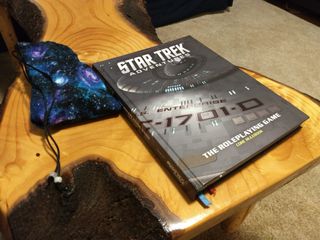
On Feb.11, 2018, the last episode of the excellent "Star Trek: Discovery" first season aired on CBS All Access. For 45 glorious minutes, I could enjoy a brand-new "Star Trek" adventure, full of action, drama, intrigue and classic, big-idea sci-fi. And then, just like that, it was all over. After 15 episodes, CBS wouldn't be providing any more "Star Trek" until 2019 .
And if CBS wouldn't make a "Star Trek" series for me, I had no choice but to make my own.
Last June, British publisher Modiphius released "Star Trek Adventures:" a tabletop pencil-and-paper role-playing game that lets enterprising players bring their own futuristic voyages to life. I hadn't played a tabletop RPG since 2012, and I hadn't played a "Star Trek" tabletop RPG since 2005. But in the past few years, I've fallen in love with the franchise all over again. After 741 episodes and 13 movies, wasn't it time to try making one of my own? [ 6 'Star Trek' Captains, Ranked from Worst to Best ]
The developers at Modiphius were generous enough to send Space.com a PDF copy of the rules. I realized quickly that I had a lot of work ahead of me if I wanted to make an adventure worthy of Gene Roddenberry's world — just working through the rule book and organizing my first session took about three months. But if you're patient, imaginative and have a fair amount of disposable income on your hands, you may find that the most memorable "Star Trek" adventure is the one you create with your friends.
What is "Star Trek Adventures"?
The Venn diagram of "people who like 'Star Trek'" and "people who play tabletop RPGs" probably has a pretty large intersection, but big, licensed games almost always draw in a new crowd. As such, it's possible that some Trekkies reading this piece have never played a tabletop RPG before. Here's how it works:
You and your friends gather together around a table, armed with some paper, pencils and dice. (Pizza and beer are optional, but highly recommended.) Three to five players take the roles of characters on a Federation starship. Perhaps one of them is an inquisitive Vulcan science officer, or a hardened Bajoran freedom fighter, or an even-tempered human captain; the rules allow for almost any kind of character you've seen on the shows, and then some.
The final player is called the Game Master. It's his or her responsibility to narrate the story, adjudicate actions, act out nonplayer characters and structure the overall adventure. In other words, the players are like the star actors, while the GM is like the writer, producer, director and supporting cast, all in one.
Get the Space.com Newsletter
Breaking space news, the latest updates on rocket launches, skywatching events and more!
In short, tabletop RPGs are half board game, half improvisational theater. The rules dictate the general actions you can take, like firing a phaser or piloting a starship, but how you tackle challenges and interact with your fellow crewmembers is up to you. RPGs are a form of collaborative storytelling, with game systems in place to keep things fun, unpredictable and fair.
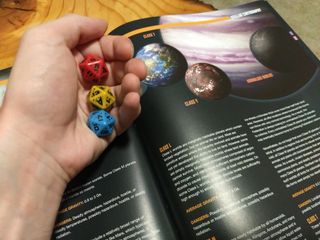
While "Star Trek Adventures" is the newest "Star Trek" RPG, it's not the first by any means. Companies have been giving players the opportunity to sit in the captain's chair ever since 1978, with everyone from Heritage Models to the RPG publisher FASA trying their hand at game design.
I can't speak to the entire history of "Star Trek" RPGs, but I did play two of them back in high school: the 1998 Next Generation ruleset from Last Unicorn Games, and the 2002 "Star Trek" Roleplaying Game from Decipher. Without going into exhaustive detail about either one, I can say that "Star Trek Adventures" is — for the most part — a cleaner, simpler and more balanced experience than the games that preceded it.
"Star Trek Adventures" runs on Modiphius' signature 2d20 system. All you need to play, as either a player or a GM, is the core rule book ($59). As in most RPGs, any time you take an action whose outcome is uncertain (whacking a Gorn warrior over the head, flying a shuttlecraft through a stellar flare, persuading a hostile Romulan ship to stand down — standard Starfleet stuff), you'll roll dice to determine whether you succeed or fail.
To help determine success or failure, each character has six attributes: Control, Fitness, Presence, Daring, Insight and Reason. These represent a character's physical and mental traits. In addition, each character has six disciplines: Command, Security, Science, Conn (computers and piloting), Engineering and Medicine. These represent a character's Starfleet training. These stats, combined with rolling two twenty-sided dice, determine whether an action succeeds or fails. Characters can also "purchase" extra dice to improve their odds with a resource called "momentum," which they’ll gain and spend constantly throughout an adventure.
Now, here's the fascinating thing about "Star Trek Adventures" as opposed to, say, "Dungeons & Dragons": your Disciplines are not inherently linked to any Attribute. You can't "min-max" your stats, assuming that your tactical officer will need high Daring, high Security, and nothing else.
Instead, Attributes and Disciplines are both situational. For example, let's return to our hypothetical security officer. Daring + Security is indeed very useful for grappling with enemies in close combat. But to fire a phaser requires Control + Security instead. Interrogating a prisoner might require Presence + Security; investigating a crime scene could be Reason + Security; chasing down a fleeing Cardassian could be Fitness + Security. Both specialized and generalized characters are viable in "Star Trek Adventures," and that's a refreshing change of pace.
Between its approachability and its versatility, "Star Trek Adventures" won me over in a big way. Adjudicating actions is simple and clear, while just about every character will have a time to shine. Whether it's a doctor making a breakthrough cure for an alien plague or an engineer patching up a shuttlecraft just in time to outrun the deadly ion storm (both of these things actually happened in my game — in the very first session!), players will be able to do the same incredible things that their favorite characters do on-screen, right out of the gate. [ The Evolution of 'Star Trek' (Infographic) ]
Starfleet's finest
"Star Trek" isn't about making a character who can do exactly one thing impeccably; it's about making a character who's versatile and adaptable, like any good Starfleet officer. It's a good thing, then, that character creation is just as fun and approachable as the core game.
If you've ever made a character in D&D, or "Pathfinder," "Star Wars," or any other mainstream RPG, character creation for "Star Trek" will feel familiar, but with a few smart twists. The default setting for "Star Trek Adventures" is that a group of players act as the senior staff of a starship or starbase, just like one of the TV shows. As such, every character is either a Starfleet officer or a petty officer — anything between a yeoman and a captain.
You have two choices to make a character: Lifepath or creation-in-play. The latter lets you distribute some stats to start, then fill in the blanks as you play, and it's easily the less interesting of the two. Lifepath lets you build a character that's uniquely yours, through either purposeful construction or randomized rolls. While it might be tempting to craft the perfect Starfleet officer, my players and I actually had much more fun randomizing our Lifepaths. There are even period-appropriate randomized tables for choosing a race, since a Voyager-era game will have more playable races than an Enterprise-era one. It's that sort of attention to canonical detail that gives the book — and the game — a lot of its flavor.
From there, you'll choose your race (Andorian, Bajoran, Betazoid, Denobulan, Human, Tellarite, Trill or Vulcan), your upbringing, your Starfleet specialization and even two career-defining events, such as a transporter accident or a first contact procedure. As you go, you'll also develop Focuses, which help you get more successes on good dice rolls, as well as Values, which determine what's most important to your character. A Focus could be something like hand-to-hand combat or astronavigation, while a Value could be "Meticulous Pride in My Work" or "The Price of Peace Is Vigilance." Players are encouraged to make up their own Focuses and Values, which adds to the free-form and personalized nature of the game.
What's fantastic about the character creation system is that it's almost impossible to make a "bad character." Having moderately good attributes and disciplines across the board rather than a handful of specializations can actually be a good thing, since you never know which combinations will be useful in any given situation.
Another thing I absolutely adore about "Star Trek Adventures" is that the characters are balanced. In the "Last Unicorn" and "Decipher" worlds, a team of players representing a bridge crew would have wildly divergent skill sets. A captain would be a much higher level than an ensign and have a whole bevy of high-level skills, whereas an ensign might have only one or two useful abilities. It made it much harder for a GM to balance a game and for each player to take the spotlight.
Instead, "Star Trek Adventures" does away with extensive skill trees and "levels." All Starfleet officers are extremely proficient, and have a chance to shine in their chosen field, regardless of experience level. Young officers get a talent that lets them reroll failed dice; veteran officers get a talent that lets them create advantageous situations more easily.
Granted, this means that there are situations in which an ensign could have nearly the same skill level as a captain, but this didn't cause any issues in my game. After all, all RPGs are an abstraction, and in theory, a player who creates an ensign character didn't do so with the intention of staging an in-game coup.
Fire phasers!
While "Star Trek" as a series is very much about getting along, it's impossible to go more than an episode or so without the characters firing a phaser or throwing a punch. Besides, combat in RPGs is usually one of the most fun parts, where dramatic tension comes to a head and characters get to save the day through tactical thinking and strategic maneuvers.
The first thing to keep in mind about combat in "Star Trek Adventures" is that it isn't "Dungeons & Dragons." Your characters are not fantastical adventurers squaring off against impossible beasts. As such, combat is usually fast and furious. A standard phaser blast can tear away half of your character's hit points in a single shot, and an unlucky stroke of a bat'leth could put him in sick bay (if he's lucky) in even less time.
Still, I much prefer the combat in "Star Trek Adventures" to the "blink and you're dead" approach of Last Unicorn, or the "player characters pretty much can't die" approach of Decipher. Players have a pool of "stress" that represents how much abstract damage they can take in combat. Drain that (or deal a ton of damage in one go), and they sustain injuries. If a character sustains three nonlethal injuries, or two lethal injuries, he or she is dead. One injury will usually knock a character out, but there are ways to mitigate this, too.
In keeping with the free-form nature of the game, you won't have to worry about battle grids and turn orders and minutiae like that. There are rules for ducking behind cover, firing wide-range phaser beams and moving around the battlefield, but they're easy to keep track of with a piece of paper and some glass beads — or even just some colored pencils.
(I tried "theater of the mind"-style combat, without beads or paper, at first, but it's a little too hard to keep track of distances that way. "Star Trek Adventures" is not as demanding as combat-heavy fantasy RPGs, but it's still important to know whether you're in melee range of an enemy, or how far away you stand when you shoot.)
Combat itself is delightfully simple, with a couple clearly defined rolls for different types of attacks. Characters can actually take a whole lot more actions during combat, from aiming their weapons to setting up elaborate traps, but the rules for those additional actions tend to get a little complex and esoteric, particularly for players who may not have a copy of the rule book handy. This is something of a recurring theme with "Star Trek Adventures.” The basics are simple, but the specifics can get complicated — sometimes unnecessarily so.
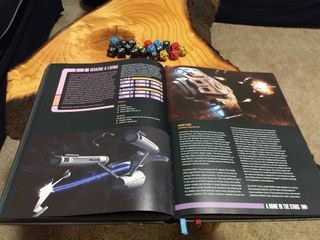
The final frontier
You can't have a "Star Trek" game without starships, and "Star Trek Adventures" provides plenty of these. Just as the players create their own characters, they will also collaborate to create their very own starship, complete with a name and NCC number designation.
Creating a starship is, for the most part, just as smooth and interesting as creating a character. I was worried that my players might each have wildly conflicting ideas about their home in the stars, but within half an hour, they'd ironed out everything from its mission profile (border patrol), to its special abilities (versatile onboard laboratories), to its name and registry number (USS Kumari, NCC-1066.)
Like characters, there are plenty of ways to make your ship unique, from its space frame to its profile. You could have a Galaxy-class vessel like the Enterprise-D on a deep-space exploration mission or a Defiant-class vessel defending the Federation from the Jem'Hadar. When you take an action aboard a starship, the ship itself gets an extra die roll to help players out. Easy enough. [ The 15 Best Ships on Star Trek, from V-ger to the USS Vengeance ]
But things get complicated in starship combat. Honestly, what the rule book needed was an example of starship combat in play, from the beginning of the encounter to the end. What we got instead is about 20 pages of complicated rules, procedures and strategies. After reading through the whole section about three times, it still took an hour to run our first two rounds of starship combat (the Kumari against a Klingon battlecruiser), and my players weren't at all clear about which actions required them to take a turn (recharging shields), and which were passive (certain sensor sweeps).
In all fairness, after those two clunky rounds, we all had a much better understanding of how things worked. And battles in space feel exciting, dangerous and impactful; two rounds were enough for the players to disable the battlecruiser's engines, and for the Kumari to sustain threatening hull damage. Like ground combat, you can decide epic confrontations in just a few rounds — but space combat rounds take much, much longer.
It's also worth pointing out that while the core rule book has a generous amount of "Star Trek: The Next Generation"-era ships, it has only one original-series-era ship (Constitution class), and absolutely nothing for "Star Trek: Enterprise"-era games. The Command Division sourcebook fills in the gaps, but it's a bit disappointing that the rules claim you can play in any "Trek" time period, then all but require you to buy another book to make the most of some of them.
Structural deficiencies
I'm comfortable saying that "Star Trek Adventures" is the best of the three "Trek" RPGs that I've played. That doesn't mean it's flawless, however. The core rule book has two major flaws: its layout and its overwhelming focus on TNG-era games.
While most RPG core rule books start out with mechanical information and discuss lore later on, the "Star Trek Adventures" core rulebook front-loads background information, even though it's the sort of background information that most people who want to play a "Star Trek" RPG will already know.
After a brief example of play (and, again, more of these would be helpful), the book launches into 70 pages of extensive backstory about the United Federation of Planets and Starfleet . This doesn't really explain how to play, and while I understand that you need to present this information somewhere in a core rule book, front-loading it keeps players from getting to the meaty stuff right away.
Furthermore, the chapter on combat is separated from the chapter on performing basic tasks by character creation and a long, strange digression about exploring alien worlds. The whole book is a little like this; all of the information you need is in there, but facts that need to go together are often dozens of pages apart. At least the index is pretty comprehensive.
As stated above, there's also a ton of focus on the TNG era, without much consideration for what it'd be like to run a game in the time of Archer or Kirk. A few sidebars clarify how to deal with earlier eras, but a full section or chapter dedicated to it might have been helpful. Some of the sourcebooks delve into this information further, but they're expensive (about $40 per book) and prioritize lore information over mechanical additions.
Bottom line
In spite of a confusing layout and some unnecessarily crunchy rules, "Star Trek Adventures" is the most accessible, balanced and imaginative "Star Trek" game to date. Everything from creating characters to buying momentum incorporates a bit of unpredictability, resulting in adventures where the characters can succeed and fail in spectacular ways. Both the players and the GM have to play fair, and it's clear from the book's gorgeous design and informative sidebars how much the developers love the source material.
If you can find a few like-minded galactic explorers, you should at least try the free quick-start rules for "Star Trek Adventures." It'll take about 3 hours to pick up and play, and by the end of it, you'll know for sure whether you want to continue your explorations. My players sure did; we've been going strong since June fighting Romulans, solving murder mysteries, rescuing Federation scientists, rooting out spies, confronting moral dilemmas and more. I even wrote some theme music for the group.
Once you get comfortable with the rules, there are only two directives to follow: engage, and boldly go.
Follow us @Spacedotcom , Facebook and Google+ . Original article on Space.com .
Join our Space Forums to keep talking space on the latest missions, night sky and more! And if you have a news tip, correction or comment, let us know at: [email protected].

Marshall Honorof is a senior editor for Tom's Guide, overseeing the site's coverage of gaming hardware and software. He comes from a science writing background, having studied paleomammalogy, biological anthropology, and the history of science and technology. After hours, you can find him practicing taekwondo or doing deep dives on classic sci-fi.
James Webb Space Telescope documentary returns to IMAX theaters this week for Earth Day. Watch exclusive clips here (video)
This Week In Space podcast: Episode 107 — Mars Sample Return Blues
Cosmic fountain is polluting intergalactic space with 50 million suns' worth of material
Most Popular
- 2 India aims to achieve 'debris-free' space missions by 2030
- 3 Scientists use AI to reconstruct energetic flare blasted from Milky Way's supermassive black hole
- 4 Earth Day 2024: Witness our changing planet in 12 incredible satellite images
- 5 NASA's Voyager 1 spacecraft finally phones home after 5 months of no contact
Continuing Mission
A Fan Site for the Star Trek Adventures RPG by Modiphius

The Thrill of Going Solo: Discovering the Universe of Solo RPGs With Star Trek Adventure’s Captain’s Log
Greetings fellow adventurers, stargazers, and storytellers!
RPGs, or Role-Playing Games, have long been hailed as the ultimate stage of interactive creativity and camaraderie. They bring us closer to people from all walks of life while offering a fantastic escape from the real world.
Yet there’s an often overlooked dimension to this universe – solo RPG.
That’s right, the journey of a lone voyager through realms of boundless imagination. With the recent release of Star Trek Adventure’s Captain’s Log solo RPG , the thrill of the lone journey is knocking at your door, inviting you to a grand cosmic voyage of discovery and self-realization.
The Solo RPG Adventure
So why are solo RPGs such an exciting pastime? Think of it as a choose-your-own-adventure book, a gaming console, and a vivid dream all rolled into one. With solo RPG, you have the freedom to weave your narrative, explore at your own pace, and make choices that can have a profound impact on the game world. You can play whenever you want, however you want, and the game morphs into your imagination’s echo.
Your character becomes an extension of yourself, and their journey feels more personal. Every victory, every defeat, every moment of wonder is yours alone to savor. You’ll not only navigate the fantastical realms of the game but also delve into the unexplored depths of your own creativity.

Set Your Phasers to Fun: Introducing Star Trek Adventure’s Captain’s Log
Speaking of creativity and exploration, Star Trek Adventure’s Captain’s Log has revolutionized the solo RPG arena. This game offers a captivating narrative-driven experience, steeped in the lore of the beloved Star Trek universe. The stakes are high, the universe is vast, and the choices are yours. Imagine sitting in the captain’s chair, the hum of the starship’s engines in your ears, and the entire galaxy in front of you.
The game is beautifully designed, intuitive, and absolutely teeming with the authentic Star Trek atmosphere. Whether you’re a dedicated Trekkie or a newcomer to the Star Trek universe, Captain’s Log provides an immersive experience that stays faithful to the spirit of the iconic franchise. This game doesn’t just offer you a story—it provides a platform for you to create your own Star Trek saga.
Star Trek Adventure’s Captain’s Log is a solo RPG game that’s perfect for anyone who loves immersive storytelling and has a hankering for some serious interstellar adventure. So, to everyone out there yearning for an escape into the universe where the only limit is your imagination, let’s engage!
Intrigued? Got questions? Reach out to me, Michael Dismuke—I’m here to help you set course for a thrilling solo RPG journey. And when you’ve started creating stories of your own, share them with us! We want to hear about your adventures. Submit your stories at Continuing Mission STA .
Take that leap of faith, warp into the thrilling realm of solo RPG, and remember—this isn’t just a game. It’s a voyage through galaxies of imagination, a journey of self-discovery, and an adventure like no other. Your Captain’s Log awaits. Are you ready to write your Star Trek saga?
It’s time to beam up and embrace the adventure!
Until next time, fellow adventurers. Live long and prosper.
TM & © 2024 CBS Studios Inc. © 2024 Paramount Pictures Corp. STAR TREK and related marks and logos are trademarks of CBS Studios Inc. All Rights Reserved.
Share this:
I have my e-book and the hard copy should arrive by Monday! Warp Factor 14!
I should add that I am 56 . When I was a pre-teen, I had a huge bulletin board and I’d pin up my Franz Joseph blueprints. I’d sit at my desk and pretend I was in engineering at my station.
Last year it was my turn to run a game with my group (we’ve been gaming weekly for over 10 years) and we had fun running STA as an episodic campaign. I think we’ll return to it next year because of the Lower Deck core book coming out. In between, I’m looking forward to some solo play.
That’s great. Do you memorialize these somehow?
Leave a Reply Cancel reply
This site uses Akismet to reduce spam. Learn how your comment data is processed .
Discover more from Continuing Mission
Subscribe now to keep reading and get access to the full archive.
Type your email…
Continue reading
The Star Dispatch
Star Trek News From All Timelines
Star Trek Adventures Captain’s Log Solo RPG Review – Stevivor
“Star Trek Adventures Captain’s Log is a deeply niche game, more so than even the descriptor of ‘solo Star Trek RPG’ would suggest,” Jam writes in …Google Alert – "Star Trek" Read More
Screen Rant
Rare baldur's gate 3 ending dialogue can only be achieved in one specific way.
A dedicated Baldur's Gate 3 fan shows off a piece of rare dialogue that can only be achieved by playing through the game with a tough restriction.
- Playing a solo run in Baldur's Gate 3 unveils rare emotional dialogue with The Emperor, showcasing a unique bond between Tav and the Illithid.
- Siding with The Emperor in the closing hours leads to a heartfelt conversation.
- While uncommon, completing a solo run in Baldur's Gate 3 reveals special interactions that shed new light on characters and add narrative depth.
Baldur's Gate 3 is a massive game filled with secrets and rare events but one fan may have just discovered one of the rarest pieces of dialogue in the entire game . While the most common way of playing through Larian Studios' RPG is to gather up a party of daring adventurers and form a competent group of killers, some players prefer to not worry about the various NPCs constantly trailing behind Tav. A "Solo" playthrough can be a difficult task given some particularly challenging boss fights but those who rise to the occasion are in for some unique events.
Posted to Reddit by user Whateverlmaoa , the player shared a piece of especially rare dialogue between the player and The Emperor that can only be seen if Tav goes through the game as a solo adventurer devoid of all party members.
Without going into spoilers, siding with the ultra-powerful Mind Flayer known as The Emperor in Baldur's Gate 3 's closing hours will see the Illithid become somewhat emotional about parting ways with Tav, going so far as to say that he values their bond. Even more special, he states that he's eager for their paths to cross again .
Baldur’s Gate 3: Are There Consequences For Using Illithid Powers?
The emperor gets a little sappy, even illithids can cry.
Given how uncommon it is for Baldur's Gate 3 players to complete a Solo Run , this exchange between The Emperor and Tav is incredibly uncommon to see . While it's only a slight variation on the dialogue that occurs should players make it to the game's end, Whateverlmaoa does not that the delivery sounds significantly more sincere than what's usually heard which makes sense given how close both Tav and the Illithid would likely become after embarking upon such a journey by themselves. It's a sweet conversation, one that sheds new light on The Emperor as a villain.
The Emperor's emotional dialogue isn't the only time he becomes very familiar with players as Tav can go so far as to romance the Illithid .
This isn't the only piece of unique dialogue that's locked behind a Solo Run of Baldur's Gate 3 but it may be one of the most narratively satisfying given everything players will need to endure to reach this point in the game . While most of the conversations will be changed slightly to accommodate for the lack of a party, NPCs will largely stick to their standard dialogue and most of the story beats will remain unchanged. Given the sheer size of Baldur's Gate 3 , it makes sense that a Solo Run wouldn't yield an entirely new script so some small tweaks here and there are appreciated.
Now that Baldur's Gate 3 has wrapped up development, fans of the Forgotten Realms and Dungeons & Dragons in general are looking to the future of the franchise. Wizards of the Coast, the company behind the franchise, has confirmed that the game's story is cannon, meaning The Emperor could show up in future adventures , depending on which ending is considered to be the "true" conclusion. Whether the Illithid leader makes a return is unknown but it's good to know that he could return.
Source: Whateverlmaoa/Reddit
Baldur's Gate 3

IMAGES
VIDEO
COMMENTS
As a solo game system to actually sit down and play it never really engaged me though. Oh well, at least we've had one good Star Trek solo adventure game this year. Star Trek Adventures Captain's Log Solo Role-Playing Game is available now. It'll set Australians back $59.30 AUD with $57.18 AUD shipping (so $116.48 AUD total).
Review: 'Star Trek Adventures' Is the Franchise's Best RPG Yet. ... An attractive feature of this new solo RPG is that gamers can inhabit any era of the "Star Trek" franchise, from the 21st to the ...
Reviewing Captain's Log, the new solo roleplaying game for Star Trek Adventures with streamlined rules for fast and easy gaming! Don't have a gaming group? ...
Star Trek Adventures' Solo RPG, Captain's Log, is going strong at GAMA. Now may be the perfect time to boldly go it alone. Solo Role-Playing has really taken off in the last few years. It is probably best not to think too hard about why because trying to look too hard at 2020 is tantamount to thinking about The Event—a fate to be avoided ...
Star Trek Adventures, like Star Trek at large, certainly could manage a blockbuster event, or a Dominion or Burn-style long arc, but it sings as an episodic game, and I think that's because the game trusts its players to bring what they know and love of Trek to the table and fly "second star to the right — and straight on 'til morning."
The Star Trek Adventures: Captain's Log Solo Roleplaying Game is an essential self-contained resource for strapped-for-time TTRPG fans, casual players and even small groups! Skip to content. Wed. Apr 17th, 2024 ... This review is based on a physical copy of Star Trek Adventures: Captain's Log Solo Roleplaying Game provided by the publisher. ...
The Captain's Log Solo Roleplaying Game is a 326-page, full-color standalone. digest-sized rulebook that provides a complete, streamlined version of the award-winning 2d20 System used for the Star Trek Adventures roleplaying game, which you can use to create your own Star Trek stories with a dynamic character formed from your own imagination.
Overview and discussion of a game that promises to let you play out Star Trek adventures on your own. Final thoughts: 38:36Get the game: modiphius.ur or modi...
Released: 2017. Players: 1+. Publisher: Modiphius Entertainment. A new addition to the Star Trek Adventures tabletop RPG allows players to explore the universe from the captain's seat all on their lonesome. The Captain's Log adapts the rules of the base game into a "streamlined version" suitable for solo play or collaborative adventures.
I've been playing Captain's Log, so now I give it a review and a once-over. I'm taking a look at the Captain's Log Solo RPG, an offshoot of Star Trek Adventu...
By Jim Johnson, STA Project Manager Art byline Art by Michele Frigo & CBS Studios Inc. If you've seen the press release about Modiphius Entertainment's newest Star Trek product, the Captain's Log Solo Roleplaying Game, you may be wondering: "What is a solo roleplaying game?". Putting it simply, a solo RPG is a pen-and-paper roleplaying game that can be played by a single player ...
The four flavours of solo Star Trek RPG are; Original Series, Next Generation, Deep Space Nine, Discovery. Each edition of Star Trek Adventures: Captain's Log is 326 pages, digest-sized and full colour. You can pre-order now, and physical books are expected to ship in August, with PDFs being delivered as soon you complete the online purchase.
Captain's Log, Star Trek Adventures Solo RPG Review. 1 comment. Best. Add a Comment. n107 GM • 1 mo. ago. Sharing our review of the recently released and wildly popular solo version of Star Trek Adventures. Reposting because something was really weird with the timestamps on the first one. My apologies.
Tabletop game publisher Modiphius Entertainment has announced a new Star Trek roleplaying game, launching the brand into the solo roleplaying game frontier, with the Captain's Log Solo Roleplaying Game.. This 326-page full color standalone digest-sized rulebook provides a complete, streamlined version of the award-winning 2d20 System® used for the Star Trek Adventures roleplaying game to ...
The 326-page, full-colour digest-sized hardcover Captain's Log Solo Roleplaying Game features: A streamlined 2d20 ruleset that enables countless ways to play. Lifepaths and roles for any type of character, not just Starfleet captains. Story-driven solo gameplay that promotes drama in a safe space. A Star Trek primer including society ...
So, Qwo has a solution in the form of the free to download Starlogs. It's a framework for solo play. I know, I've just mentioned two freebies; Phasers + Photons and Starlogs. Both are by Qwo, so if you're a sci-fi RPG fan then they might well be worth following on Itch.io. Starlogs is a generous 24 pages long for a freebie.
An incredibly wide-ranging ruleset with plenty of options for exploring strange new worlds and seeking out new life and new civilisations, but probably not an ideal first step into the world of tabletop RPGs. Publisher: Modiphius. Price: £44.99. Genre: RPG. Players: 2+.
Our RPG journey with Star Trek Adventures and Captain's Log Solo RPG was a compelling exploration of two distinct systems. We uncovered some great insights regarding the conversion to Captain's Log, and discovered that a blend of both systems would be the ideal approach for our group. The structured nature of STA appealed to some players ...
Star Trek Adventures: Captain's Log Solo Roleplaying Game proves that there's plenty of space in the galaxy, and we can play however we want in it. Jeff Provine is a Composition professor, novelist, cartoonist, and traveler of three continents. His latest book is a collection of local ghost legends, Campus Ghosts of Norman, Oklahoma.
Now, the company making sure Trekkies can explore space solo with the Star Trek Adventures: Captain's Log Solo Roleplaying Game. The new game is a 326-page standalone rulebook that guides players through creating a character and playing out their story. Players can play alone, with friends collaboratively, or with a gamemaster running things ...
published 2 October 2018. Space.com tested out "Star Trek Adventures," a pencil-and-paper roleplaying game that lets a group of players bring their own futuristic voyages to life.(Image credit ...
Set Your Phasers to Fun: Introducing Star Trek Adventure's Captain's Log. Speaking of creativity and exploration, Star Trek Adventure's Captain's Log has revolutionized the solo RPG arena. This game offers a captivating narrative-driven experience, steeped in the lore of the beloved Star Trek universe. The stakes are high, the universe is vast, and the choices are yours.
Star Trek Adventures Captain's Log Solo RPG Review - Stevivor. By: Posted on September 12, 2023 "Star Trek Adventures Captain's Log is a deeply niche game, more so than even the descriptor of 'solo Star Trek RPG' would suggest," Jam writes in …Google Alert - "Star Trek"Read More. Tags: Star Trek.
About: "Experience a vampire survival action RPG adventure like no other. Awaken after centuries of slumber, weakened and thirsty for blood. Explore a vast open world of dark fantasy, humans ...
A dedicated Baldur's Gate 3 fan shows off a piece of rare dialogue that can only be achieved by playing through the game with a tough restriction. Custom Image by Katarina Cimbaljevic. Summary. Playing a solo run in Baldur's Gate 3 unveils rare emotional dialogue with The Emperor, showcasing a unique bond between Tav and the Illithid.